Screen Rant
All 34 star trek ships in picard's anomaly mission.
Star Trek: Picard season 2, episode 1 saw Jean-Luc Picard's anomaly mission supported by a vast fleet of Starfleet ships - here's all of them.
This article contains spoilers for Star Trek: Picard season 2, episode 1.
Star Trek: Picard season 2, episode 1 featured a dramatic confrontation with a Borg anomaly - and here's all you need to know about the 34 Starfleet vessels that confronted the Borg. Star Trek: Picard season 2 moves even further forward in time, with Picard summoned to an anomaly that turns out to have been created by the Borg . Soon a vast fleet of Starfleet vessels has arrived to support the USS Stargazer.
Most of the designs seen in Star Trek: Picard season 2 are actually new to viewers, although several originate in Star Trek Online . That means the capabilities of these starships are unknown, but they're presumably significant. Fortunately, none of these designs were put together at random; the show's producers have put an incredible amount of time and effort into thinking them through, and several of them contain smart Easter eggs.
Related: Star Trek: Picard Just Destroyed Burnham's Captain Catchphrase
In the wake of Star Trek: Picard season 2, episode 1, production designer Dave Blass took to Twitter to unveil the 34 starships present during this confrontation with the Borg. He also revealed gorgeous artwork of each ship, giving a better look at them all. Here's everything you need to know about all the participants in this latest battle with the Borg.

The USS Avalon Discovers Star Trek: Picard's Anomaly
The Borg anomaly is initially discovered by the USS Avalon, one of the few vessels to actually be named in Star Trek: Picard season 2, episode 1. The second starship to bear this name, the Avalon is an Akira-class vessel; according to Blass, it has the registry number NCC-63887. Viewers may well recognize the basic profile from Star Trek: Deep Space Nine , where Akira class starships fought on the front line of the Dominion War . Artwork of the USS Avalon was created by Geoffrey Mandel.
Several other Akira-class starships joined the growing fleet in Star Trek: Picard , including the USS Thundercloud (NCC-63549), the Helios (NCC-63284), and the Rabin (NCC-63293). Artwork of the USS Helios and the USS Rabin is by Thomas Marrone; the image for the Rabin was reused for the USS Thundercloud.
The USS Stargazer Arrives On The Scene In Star Trek: Picard Season 2
The USS Stargazer was Jean-Luc Picard's first command, and it's appropriate the new Stargazer is captained by Chris Rios, a man who was drawn back into Starfleet. The first of the new Sagan-class starships, the Stargazer (NCC-82893) is equipped with technology derived from research on the Borg Artifact . Unfortunately, this proves to leave the ship vulnerable when the Borg Queen transports aboard and uses the Borg components to begin a process of assimilation. The illustration of the USS Stargazer is by John Eaves.
Related: Picard Reveals Star Trek: DS9’s Darker Timeline
The USS Excelsior & USS Eureka Respond To The Stargazer
Another responder is the USS Excelsior (NCC-42037). Cadet Elnor and Commander Raffi Musiker serve aboard this Excelsior-class starship, and their vessel took the Stargazer's flank during the confrontation with the Borg Queen's vessel . The first Excelsior-class ship was introduced in Star Trek III: The Voyage Home , and they've served as the backbone of the Federation since the days of Captain James T. Kirk. Artwork of the USS Excelsior is by John Eaves.
Appropriately enough, the USS Excelsior is accompanied by another of its class, the USS Eureka (NCC-42023). This is not the first vessel to bear this name - at least in the wider lore, with an earlier USS Eureka going up against the Borg in Star Trek games. Artwork of the USS Eureka is by John Eaves.
The USS Rustazh & Inquiry-Class Starships In Star Trek: Picard Season 2
The Inquiry-class starships were actually introduced in Star Trek: Picard season 1, with William Riker captaining the USS Zheng He (NCC-86505) when he arrived to help Jean-Luc Picard out. He described it as " the toughest, fastest, most powerful ship Starfleet ever put into service, " although only five ships of this class joined the fleet action against the Borg.
The five Inquiry-class ships seen in Star Trek: Picard season 2, episode 1 were the USS Rustazh (NCC-86503), the USS Magellan (NCC-86509), the USS Nathan Hale (NCC-86501), the USS Shackleton (NCC-86517), and the USS Zheng He itself. Artwork is by Tobias Richter.
Related: Star Trek Changes Picard's Starfleet Captain Legacy (Because Of Pike?)
The USS Gilgamesh & Other Sovereign-Class Vessels Join Starfleet's Fleet
Named after the Sumerian monarch, the USS Gilgamesh (NCC-74669) is a Sovereign-class starship - the same model as the USS Enterprise-E . They've always been heavily armed, and have been at the front lines of many clashes with the Borg. The Enterprise-E went through several refits over the years, so it's reasonable to assume the Gilgamesh and her fellow Sovereign-class vessels have up-to-date Starfleet weapons.
Gilgamesh isn't the only Sovereign-class starship at this latest encounter; there is also the USS Arsinoe (NCC-75307), the USS Hrothgar (NCC-74975), the USS Hutchinson (NCC-74957), the USS Okuda (NCC-74107), the USS Pachacuti (NCC-74181), the USS Valkyrie (NCC-74877), and the USS Venture (NCC-75306). Artwork of the USS Gilgamesh is by John Eaves.
Star Trek: Picard Establishes The Luna-Class
When Will Riker first became a captain, he took command of the USS Titan - which was described as a Luna-class starship in one official quiz. The class was then made canon in Star Trek: Lower Decks , and Star Trek: Picard features a shot of the USS Luna (NCC-80101) itself, along with the USS Oberon (NCC-80103). The design for the USS Luna was created by Sean Tourangeau, while the artwork is by Tobias Richter.
The USS Uhura Is A Wonderful Star Trek Easter Egg
The USS Uhura (NCC-90214) is, of course, a wonderful Easter egg to the original Star Trek series - and to Nichelle Nichols' unforgettable portrayal of Nyota Uhura, one of Kirk's bridge crew. It's a Reliant-class starship, and like several of the new designs seen in Star Trek: Picard episode 1 it originates from an unprecedented collaboration between the show's production team and Star Trek Online 's designers.
Related: Star Trek: Picard's Backstory Completes Patrick Stewart's Character Change
There are two other Reliant-class ships present during the confrontation with the Borg; the USS Clark (NCC-90206) and the USS Reliant (NCC-90200). Artwork is by Thomas Marrone.
Four Sutherland-Class Starships Join Star Trek: Picard's Fleet
There are four Sutherland-class starships among the fleet; the USS Almagest (NCC-91870), the USS Huygens (NCC-91814), the Ibn al-Haytham (NCC-91965), and the USS Sutherland (NCC-91800). This class was designed for the Star Trek Online game, where it was described as a variation of the 24th-century Nebula class. Artwork is by Thomas Marrone.
The USS Gagarin Joins Star Trek: Picard's Fleet
The USS Gagarin (NCC-97930) is presumably the prototype of a new Gagarin-class starship in service during Star Trek: Picard 's time perio d. In common with the Sutherland, this design originates with the Star Trek Online game, incorporating elements of that into main canon. Artwork of the USS Gagarin is by Donny Versiga.
Two Vanguard-Class Vessels Are Seen In Star Trek: Picard Season 2 As Well
Named after celebrated Native American engineer Mary Golda Ross, the Ross-class starship was also developed for Star Trek Online - this time as part of its 10-year celebrations. These ships are similar to the classic Galaxy-class, but with aspects of more modern designs.
Related: Picard Finally Shows The Borg's Potential Star Trek Has Always Ignored
Two Ross-class ships join the fleet, the USS Vanguard (NCC-75148) and the Yi Sun-Shi (NCC-76545). It's interesting to note modern Star Trek starship names are drawn from a wider range of historic Earth cultures; the Yi Sun-Shi is named after a celebrated Korean admiral and warlord from the Joseon Dynasty. Artwork is by Thomas Marrone.
Star Trek: Picard season 2, episode 1 ended with Q rewriting history, launching Jean-Luc Picard into an alternate timeline for his own inscrutable reasons. Given that's the case, it's likely this is the only Starfleet armada that will be seen in season 2 - although it's quite possible Picard will see a fleet from this altered timeline as well. When the timeline is presumably reset, it will surely mean history is rewritten and this fleet doesn't suffer the fate of Borg control.
More: Star Trek: Picard Confirms Q & Guinan Age Theories
Star Trek: Picard Season 2 streams Thursdays on Paramount+.
Star Trek: Picard: Analyzing All The Ships From Season One
From aircar to Zheng He (if we were going in alphabetical order).
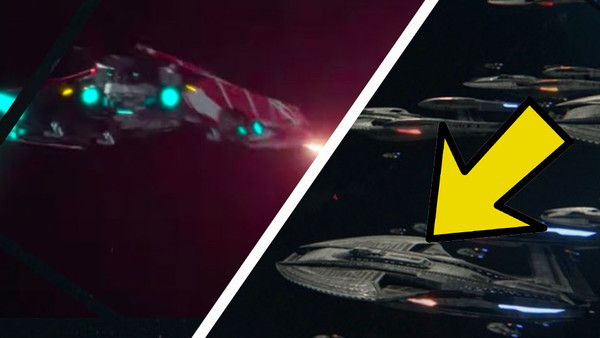
The first season of Star Trek: Picard may contain the least amount of trekking in the Star Trek franchise; it's a series more interested in the character study of Jean-Luc Picard and his cohorts than in the study of the technical specifications of the La Sirena or the Borg Artifact. Still, it wouldn't be Star Trek without a little spaceship porn and Star Trek: Picard delivers several new and exciting starships – as well as a couple old and exciting starships as well.
These starships range from numerous updated Romulan craft to the gigantic cut-and-paste Federation armada that faced off against the Zhat Vash in the season finale.
Here are all the starships (and shuttles) in Star Trek: Picard Season One (in order of appearance).
16. USS Enterprise NCC-1701-D

The first ship to appear in Star Trek: Picard is appropriately the one that started Picard on his journey over 30 years ago: The Galaxy-class USS Enterprise, NCC-1701-D.
The D appears in the first minutes of the series in the dream sequence that opens "Remembrance" and later as a holographic tribute at Starfleet Headquarters in "Maps and Legends". She's a welcome sight after her last on screen appearance in the less than stellar Star Trek: Enterprise series finale "These Are the Voyages..." in 2006.
While Picard would go on to command the USS Enterprise-E in Star Trek: First Contact through Star Trek Nemesis and (according to the Star Trek: Picard Countdown comics) the USS Verity after that, the Enterprise-D will always be Picard's most famous ride.
I played Shipyard Bar Patron (Uncredited) in Star Trek (2009).
- Schedules and Guides
- 2020 Schedule
- 2021 Schedule
- Reading Order
- Starships Index
Friday 3 April 2020
The starships of star trek picard.

2 comments:
I spent the whole show waiting for a new starfleet capital ship to appear, and when it finally did... it's so ugly.
That shuttle design on mars appears to go back even further than 2011, it appears first as unused concept art for ST09 https://i.imgur.com/06SPABm.png
Post a Comment
How Star Trek: Picard Season 2 fixed its biggest starship controversy
The makers of Star Trek: Picard heard fans didn't like that starship fleet in 2020. Here’s how they corrected that, with a big assist from Star Trek: Online .
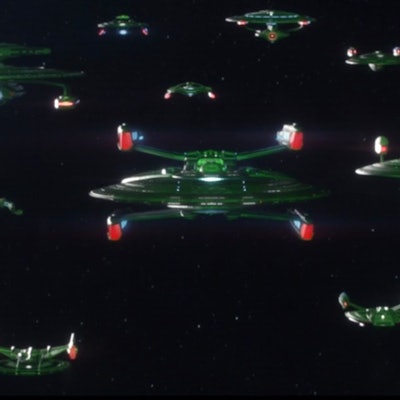
Starfleet has come home.
For the first time since Star Trek returned to TV in 2017, the visual vibe of Starfleet suddenly looks like it did in the Next Generation era. In the Season 2 premiere of Star Trek: Picard, “The Star Gazer,” a huge Federation fleet arrives to tango with a bizarre new Borg craft, and the ships in this fleet are instantly recognizable. But the last time we saw a fleet of starships from this era, in the Season 1 finale of Picard, the visual aesthetic was decidedly different. With the introduction of a new USS Stargazer and a plethora of familiar starships, Picard has gone all-in on canonical fan service. Spoilers ahead.
But how did this happen? Picard production designer Dave Blass listened to fans who didn’t like the “copy-and-paste” fleet from Season 1, and he enlisted the help of starship makers for the MMO Star Trek: Online . Inverse caught up with both Blass and Star Trek: Online starship guru Thomas Marrone to talk about the new Stargazer , the canonical appearance of several starships from Star Trek: Online, and why, as fans, it was important to get the ships right.
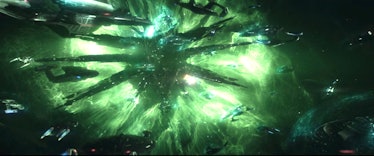
The fleet takes a hit from the Borg in Star Trek: Picard Season 2.
A new Starfleet
As the Season 1 finale of Star Trek: Picard aired in 2020, Dave Blass was already working on Picard Season 2.
“We got the script and found out we were going to do a new ship and that ship was going to be the Stargazer , and that there was going to be a whole fleet in this episode, too,” Blass explains. “And at the same time, the Season 1 finale drops, and fans had a reaction to the Zheng He fleet, and they’re not happy.”
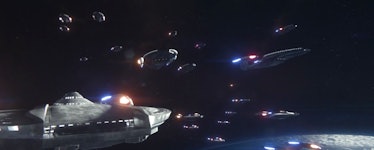
Riker’s fleet of ships in the Picard Season 1 finale was formidable, but a little bit same-y.
Blass is referring to the moment in “Et in Arcadia Ego Part 2” when Riker arrives with a fleet of nearly identical Starfleet ships led by the USS Zheng He . While there was some slight variation, the fact that most of the ships pretty much looked the same irked some fans. Blass says he saw all this chatter and decided to make a change for the big Season 2 fleet scene.
“I know that there's a lot of practical reasons why things happen,” Blass says of the Season 1 fleet. “But I was like, okay, I wonder if there's a way to solve this problem. To turn the obstacle into an opportunity.”
The goal was to give fans a fleet that represented the ships they know and love from the TNG, Voyager, and Deep Space Nine eras. The new Stargazer was going to take center stage, but Blass wanted the ships that arrive for back-up to be ones we know. But the Picard team was short on resources and needed more digital animators to create individual ships, so instead of creating new digital models Blass looked for where they might already exist.
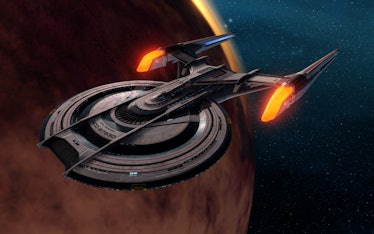
The USS Gagarin from Star Trek: Online .
Star Trek: Online becomes canon
To round out the new fleet for Picard Season 2, Blass contacted Star Trek: Online designer Thomas Marrone with a big idea: To put early 25th century Starfleet ships from the game on screen for the first time.
“I found these ships from Star Trek Online and I was like damn, these are really good looking,” Blass explains. “I was like ‘why are we not doing something here?’ So I reached out to Thomas.”
Blass explains that he wanted the talent of Star Trek: Online’s animators because he needed “people who know how to design Star Trek ships and that [know] a Star Trek ship is not a Star Wars ship.”
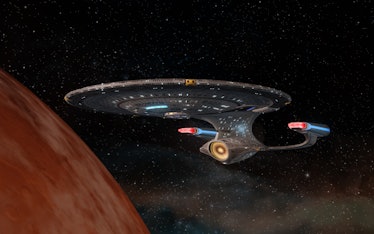
The Ross class, designed by Thomas Marrone.
“It was kind of old hat to us,” Marrone says. “We knew what the pitfalls were, what the hard things to do were, and how you take something that's familiar and expand upon it while still making it easily identifiable. We want fans to say, ‘that's a Starfleet ship.’ That's a new version of the Galaxy [class] or whatever. It was always something I’d fantasized about, but when Dave reached out it was certainly a dream come true for us.”
For fans of Star Trek: Online , this meant that several classes of ships are now canonical, including the Ross-class exploration cruiser and the Reliant-class light cruiser. But Marrone and Blass made it clear that the entire fleet in the Picard Season 2 debut isn’t only populated by ships from Star Trek: Online . You’re also seeing a lot of ships from the latter TNG era, including the Akira -class from First Contact and the famous S overeign- class.
“Some of those are the models from the game,” Marrone says. “But we also helped with some existing canon ships. We had a great back catalog of canon ships, they took our models and textures and brought them into their pipeline.”
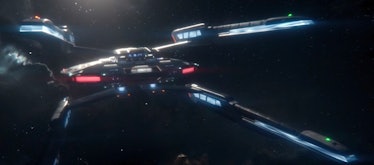
The new USS Stargazer
The new Stargazer
If you think the bridge of the new USS Stargazer looks really big, Dave Blass wants you to know that’s (kind of) an illusion. The Stargazer bridge isn’t as big as the Discovery bridge, and only a little bit bigger than the bridge of the Enterprise-E .
“It’s 10 feet wider than [the bridge of] the Enterprise-E,” Blass says. “And mainly that’s for tactical reasons. We’re shooting widescreen with multiple cameras. The cameras are likely to crossover and you have to get that camera out of the view of the other camera.”
Blass also clarifies that in terms of overall size, the new Stargazer is “smaller” than the USS Enterprise- D from The Next Generation .
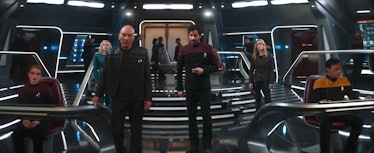
The bridge of the new USS Stargazer .
First introduced in the Next Generation episode “The Battle,” Jean-Luc Picard’s first captaincy before the Enterprise was the USS Stargazer, registry NCC-2893. But the new Stargazer is NCC-82893. Unlike some other starships that share a name, the new Stargazer didn’t get a letter affixed to its number. Instead, it just got an extra digit. Why not make the Stargazer NCC-2893-A? Or B, or C?
Blass has a good answer.
“I dropped the hammer on this one,” he reveals. “The Stargazer is an important ship, but it does not hold the status in the Federation that the Enterpris e had. I didn’t feel it was warranted. Because then every ship gets it and it becomes a thing. The Stargazer didn’t have that legacy.”
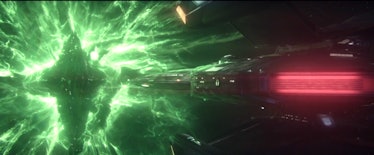
The Stargazer versus the new Borg ship.
For fans who think this is some kind of blasphemous deviation from canon, Blass points out that there have been several USS Intrepids in Trek canon, but those aren’t connected by an identical registry number and a sequential letter.
And just in case fans are wondering, yes, there are three versions of the USS Stargazer in Trek canon now. As glimpsed in Rios’ conference room, we see models of Stargazers from the TOS- era, the famous one from the TNG -era, and now, the new one. Blass and model-maker Bill Krause have confirmed the classes for these three Stargazers, too. The oldest one is Radiant- class, Picard’s classic one is Constellation- class. The new Stargazer is Sagan-class, probably named for Carl Sagan. (Or perhaps Nick Sagan, Carl’s son, who wrote for both TNG and Voyager ! )
Why Star Trek ships endure
Digging into the nitty-gritty of Trek starship canon circles around one interesting fact: Essentially all Starfleet ships descend from the basic design of the USS Enterprise, created by designer Matt Jefferies in 1964. Why is this design so iconic, and why has it inspired so many offshoots and remixes?
“That arrangement has survived over 50 years,” Marrone says. “We’re still riffing on that. Gene Roddenberry told [Jefferies] it has to look fast, but it can’t have smoke or flame coming out of the back. So it’s gonna woosh by the camera really fast, and he needed to come up with shapes you could instantly recognize. And that’s how he landed on the saucer, and the neck and the nacelles. That added a certain grace and character, I think.”
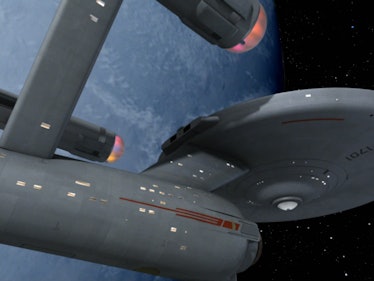
The digitally remastered USS Enterprise in The Original Series .
In Star Trek V: The Final Frontier , Captain Kirk quotes the poem “Sea-Fever” by John Masefield, with the line “All I ask is a tall ship and a star to steer her by.” And Marrone thinks that notion of a “tall ship” is exactly why we still love these designs five decades later.
“It’s not X wings and it's not WWII battleships,” Marrone says. “Its age-of-sail, Horatio Hornblower. We’re still in love with that ‘tall ship.’ And that’s because it’s like a character on the show.”
Star Trek: Picard is streaming on Paramount+.

Ryan Britt's new book on the history of Star Trek's biggest changes. From the '60s show to the movies to 'TNG,' to 'Discovery,' 'Picard,' Strange New Worlds,' and beyond!
- Science Fiction
Federation Stardate: 40401.2

Polar Lights 1/350 Star Trek TOS USS Enterprise Saucer Section

Star Trek Strike Force Ferengi Marauder 1997 Playmates TV Movie Sealed

Star Trek - Champions Fine Pewter Figure - Klingon Bird of Prey - 1984 NEW

Micro Machines Star Trek the Movies (Collection 2)

Star Trek Micro Machines The Original Collection #1 Enterprise Romulan Klingon

STAR TREK USS ENTERPRISE NCC-1701-A DEDICATION PLAQUE REPLICA

Hero Collector Eaglemoss U.S.S. Pegasus NCC-53847 XL Edition

USS KOBAYASHI MARU

Star Trek The Official Starships Collection | U.S.S. Enterprise NCC-1701-J XL Ed

Spock’s Jellyfish Ship

USS SHENZHOU

USS TOUSSAINT Star Trek PICARD Eaglemoss
Uss zheng he.

Star Trek The Official Starships Collection | U.S.S. Bonchune Nebula-Class XL Ed

Star Trek Special Edition 3-Piece U.S.S. Enterprise Chrome Set

Star Trek Space Ship Set Model Kit

Star Trek The Next Generation Klingon Bird-Of-Prey Figurine By Enesco
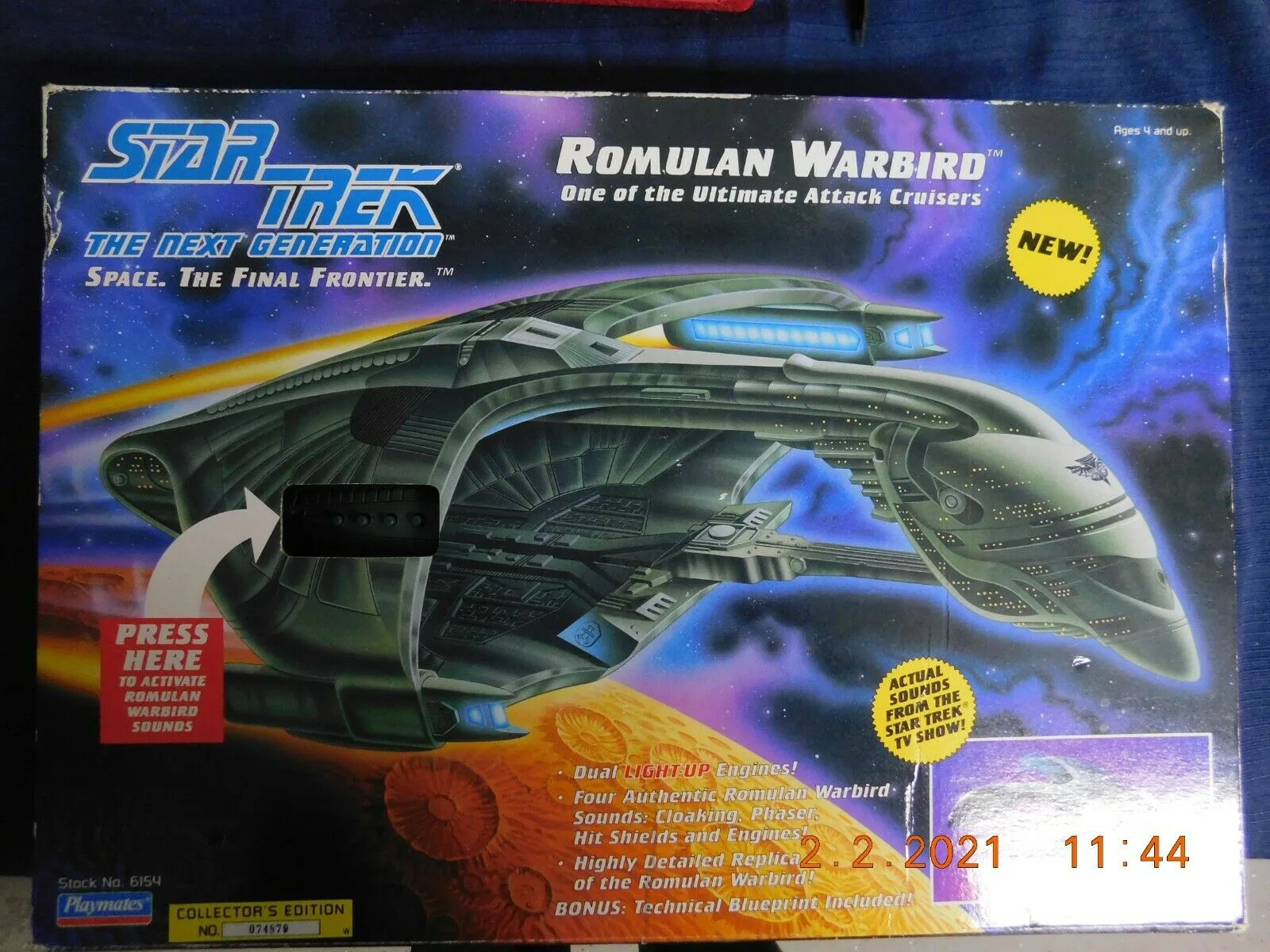
Star Trek The Next Generation ROMULAN WARBIRD Playmates El

Star Trek - Klingon Battle Cruiser Flying Model Rocket 25th Anniversary Edition
- The Original Series
- The Animated Series
- The Next Generation
- Deep Space Nine
- Strange New Worlds
- Lower Decks
- Star Trek Movies
- TrekCore on Twitter
- TrekCore on Facebook

The "Star Trek" franchise, for more than 55 years, has defined mainstream science fiction in the United States with its utopian vision of the future. Created by Gene Roddenberry, "Star Trek" — which spans numerous television series and feature films — follows the United Federation of Planets and its spacefaring force Starfleet as they explore the galaxy. Boasting a wide armada of unique vessels to keep the peace and invite other civilizations into its ranks, Starfleet's starships have taken on a fan-favorite legacy of their own. Capable of traveling faster than the speed of light, these starships also are equipped with weaponry to take on the most fearsome threats in the cosmos.
Check out this comprehensive ranking of the 12 most important starships in Federation history throughout the "Star Trek" franchise. The ranking — not based on the quality of the shows or movies, and certainly not their penchant for action – addresses their place in making the Federation what it is in-universe.
12. USS Cerritos NCC-5567
The animated series "Star Trek: Lower Decks" centers on the low-ranked Starfleet personnel who handle the organization's more menial tasks. Their duties include carrying out routine maintenance, cosmic clerical work, and other thankless jobs. Such assignments tend to fall to the crew members aboard California-class starships, including the overlooked men, women, and aliens who serve on the USS Cerritos NCC-5567, the main vessel on "Lower Decks." Fortunately, in addition to poking fun at "Star Trek" tropes , "Lower Decks" explores the notion of overcoming expectations, with the Cerritos' ensigns rising above their assumed stations — along with their ship.
Because of all its wacky hijinks, among them foiling a terrorist plot targeting the Federation, the Cerritos has reached legendary status among California-class starships by Season 3. The Cerritos' impressive reputation plays a pivotal role in the third season finale, rallying other California-class starships to stop a rogue artificial intelligence from attacking Starfleet. "Lower Decks" is all about the ideas that no task is too small or unimportant and that the little guys deserve respect too. And as the California-class ship leading the charge, the Cerritos earns the right to stand among its more nominally elite counterparts.
11. USS Enterprise NCC-1071-A
The Klingons destroyed the original Constitution-class Enterprise during a showdown in "Star Trek III: The Search for Spock." It seems only fitting that its replacement, the USS Enterprise NCC-1701-A finally facilitates an armistice between the Federation and Klingon Empire. The swan song for the "Original Series" crew, "Star Trek VI: The Undiscovered Country" finds Captain Kirk leading a diplomatic mission to broker peace with the Klingons. However, a conspiracy poised to plunge Starfleet and the Klingon Empire back into an active war threatens this unprecedented cooperation between the two rival governments.
The Klingons rank as one of the bitterest enemies the Federation has ever faced, nearly conquering them outright during "Star Trek: Discovery." Peace between the two seemed inconceivable but, despite everything the Klingons cost him personally, including his only son, Kirk makes an armistice possible. This alliance not only brings the two governments together but saves them from the Dominion during "Star Trek: Deep Space Nine." The Enterprise-A also confronts a powerful entity masquerading as God in "Star Trek V: The Final Frontier" but the less perhaps said about that adventure, the better.

10. USS Protostar NX-76884
The USS Protostar NX-76884, the main starship from the CG-animated series " Star Trek: Prodigy ," has already left its mark on the Federation, though certainly not as intended. A spacefaring prototype, the Protostar's warp drive is complemented by the inclusion of an experimental proto-drive, powered by an actual, small protostar. When fully powered, the proto-drive allows the starship to travel to different quadrants around the galaxy in an instant, exponentially faster than warp drive-propelled starships. Chakotay initially captained the Protostar, doing so until before he and the starship were captured by the villainous Diviner, with a ragtag crew of refugee children reclaiming it.
The scientific breakthroughs behind the Protostar alone warrant its appearance on this list but its role in Prodigy's first season finale makes it an infamous inclusion. While under the Diviner's control, the Protostar is infected with an advanced computer virus acting as a Trojan horse for any Federation systems with which it interfaces. Once infected, defensive systems go out of control and attack any other Federation targets in the immediate area. While the Protostar crew stops the virus' spread, it infects and devastates a significant portion of Starfleet's armada, transforming the Protostar into the fleet's deadliest vessel.
9. USS Titan NCC-80102-A/USS Enterprise NCC-1701-G
The Protostar and Cerritos incidents are far from the only times Starfleet has nearly been destroyed from within. The final season of "Star Trek: Picard" reveals the remnants of the Borg Collective and the Dominion have formed an alliance to infiltrate and annihilate the Federation. Using Borg technology, Changelings modify Starfleet transporters to secretly assimilate younger personnel, creating sleeper agents across the armada. The ship that uncovers this far-reaching conspiracy? The USS Titan NCC-80102-A, with nominal Captain Liam Shaw led by Admiral Jean-Luc Picard.
The Titan plays a pivotal role in distracting the assimilated armada from bombarding Earth's planetary defenses, giving Picard and the Enterprise-D valuable time to disrupt Borg communications. Though the Titan is disabled by the opposition, without its diversion, the fleet would have proceeded to bomb Earth's major cities before spreading their devastation across the galaxy. The Enterprise-D may get the glory for ultimately defeating the Borg and saving the day, but Titan merits recognition for playing good defense single-handedly. In the "Picard" series finale, the powers that be rechristen the Titan-A as the USS Enterprise NCC-1701-G , cementing its importance and heroic legacy.
8. USS Discovery NCC-1031
Across the Federation's entire history, the USS Discovery NCC-1031 rates as the most unique starship, thanks to its Spore Drive. A sentient set of spores within the Discovery's engineering section interface with Chief Engineer Paul Stamets, allowing the ship to leap through subspace. More than simply traversing great distances in an instant, the Spore Drive gives the Discovery limited access to the Mirror Universe.
The Discovery not only assumes a pivotal role in stopping the bloody war between the Federation and the Klingon Empire but saves it from an enemy within its ranks. In the Season 2 finale, the Discovery teams up with the Enterprise to destroy Control, a rogue artificial intelligence poised to wipe out all organic life in the galaxy. And just as Discovery preserves the Federation's existence in the relative present, it also restarts its legacy in the far future. Transported more than 900 years into the future, the Discovery inspires the Federation to rebuild itself from a massive catastrophe, restoring its ideals across the stars.
7. USS Enterprise NCC-1701-E
Just as Kirk commanded two starships with the Enterprise moniker, Picard gets his second Enterprise in the 1996 film "Star Trek: First Contact." Commander Will Riker describes the Enterprise-E as the most advanced in the entire fleet and one better outfitted for combat than its predecessor. While not as prolific as the Enterprise-D, the ship spares the Federation total defeat on at least two separate occasions. The Enterprise-E also uncovers a conspiracy within Starfleet Command in "Star Trek: Insurrection," exposing a group undermining the Federation's principles.
The Enterprise-E's superior weaponry and Picard's intimate knowledge of the Borg save Earth and the defending Starfleet armada from the Borg Queen. This timely intervention also involves the Enterprise-E following the Borg into the 21st century to defeat them and ensure the preservation of humanity's history. Later, the Enterprise-E takes point in brokering a landmark peace agreement with the Romulan Empire in "Star Trek: Nemesis." With no armistice achieved without significant complications, the Enterprise-E takes down a rogue Romulan warship targeting Earth, proving itself as capable in a fight as diplomatically.
6. USS Voyager NCC-74656
The USS Voyager's most famous mission strands it on the far side of the galaxy, approximately 70 years from home and without Starfleet support. Captained by Kathryn Janeway, it took the starship seven seasons to return to the Alpha Quadrant, exploring the true undiscovered expanse within the Delta Quadrant along the way. Encountering new species and phenomena, the Voyager upgrades itself during its long journey to accelerate its trip significantly. While the sheer amount of exploratory information and technological enhancements are enough to make the Voyager stand out in Starfleet, its final act remains its noteworthiest.
In the last leg of the ship's voyage, Janeway teams up with an alternate future version of herself to destroy the Borg Collective seemingly for good. The older Janeway allows herself to be captured by the Borg Queen, infecting her with a terminal virus that spreads across the Collective. Though the Borg are revealed to survive in a diminished capacity decades later, the incident represents a major victory for the Federation. Voyager not only returned to the Federation with a wealth of new information, but the ship vanquished its greatest foe to deliver an interstellar mic drop.
5. USS Defiant NX-74205
" Star Trek: Deep Space Nine " marks a departure from the franchise's established formula, with its characters not on an exploratory mission but maintaining a strategically located space station. In the third season, the crew welcomes the USS Defiant NX-74205 in order to engage in away missions around the cosmos. As "Deep Space Nine" evolves into a show depicting Starfleet at war, here comes a primary vessel designed specifically for combat. And it boasts not only remarkable maneuverability and a formidable weapons system, but the Defiant is one of the few Starfleet vessels with a functional cloaking device.
The Defiant figures prominently in the Dominion War, outmaneuvering and concealing itself from even the deadliest Jem'Hadar vessels, and playing a major role in Starfleet's eventual victory. After Starfleet temporarily loses control of Deep Space Nine, the Defiant embarks on a series of strikes on vital Dominion targets in the quadrant. Beyond its seek-and-destroy function, the Defiant heads the armada that retakes the station. The original Defiant is destroyed by the Breen in the show's final episodes, with Captain Benjamin Sisko receiving an identical replacement shortly thereafter to finish the fight.
Zefram Cochrane, the most revered figure in 21st-century human history, became the first person from Earth to achieve lightspeed spaceflight. Aboard his makeshift starship, the Phoenix — fashioned from a repurposed Titan II nuclear missile in Montana — Cochrane makes his fateful voyage in 2063, aided by the time-traveling Enterprise-E crew. Vulcans immediately take notice of humans emerging as a warp-capable civilization, prompting them to make first contact with Earth and lay the groundwork for what will become the Federation. After the successful flight, Cochrane continues to improve upon his warp drive designs, with his innovations informing the development of subsequent generations of starships.
Though the flight of the Phoenix occurs well before the Federation's founding, its influence cannot be overstated as it's felt for centuries to follow. The Borg Collective identify the Phoenix's landmark flight as a turning point in the galaxy's narrative, attempting to disrupt it to ensure their domination. More than 300 years later, Beckett Mariner hijacks the Phoenix to gain access to the Cerritos in the "Lower Decks" Season 3 premiere, proving the ship is still mission-ready. Even centuries after Cochrane's disappearance while exploring the cosmos, the Phoenix continues to make history.
3. USS Enterprise NCC-1701-D
The Enterprise-D may be the fifth NCC-1701 starship to carry the name but it belongs among the most vital in the Federation. Captained by Jean-Luc Picard, the Enterprise-D soars as the main ship in "Star Trek: The Next Generation" and the 1994 film "Star Trek Generations." The final season of "Star Trek: Picard" reveals Chief Engineer Geordi LaForge salvaged the Enterprise-D, quietly repairing it over time to make it fully operational again. This repair job proves instrumental in the Enterprise saving the galaxy once again, adding to its vaunted status within Starfleet.
The Enterprise-D crew are the first ones to rescue the Federation from the Borg, while Picard himself convinces the omnipotent Q that humanity deserves to exist. Much like the original Enterprise NCC-1701 goes out with an anticlimactic bang, so too does the Enterprise-D, scuttled stopping the terrorist Soran from manipulating the Nexus anomaly. Fortunately, the Enterprise-D gets a better, if delayed, swan song in saving the Federation from the resurgent Borg in "Picard." Even decades after its initial service, the Enterprise-D holds a legendary place for the Federation, more than worthy of the value that comes with its name.
2. USS Enterprise NCC-1701
The first Constitution-class Enterprise enjoys a storied history that surpasses that of any other starship in the franchise to date. The original USS Enterprise NCC-1701 appeared as the main ship in "Star Trek: Strange New Worlds," "The Original Series," and the franchise's first three films. Helmed by iconic captains like Christopher Pike and Jim Kirk, the Enterprise is the most important starship of its era. As a testament to the Enterprise's importance being recognized in-universe, no less than seven starships carry the moniker so far.
In "The Original Series" alone, the Enterprise saves the Federation from dozens of enemies and dangerous phenomena that endanger it. From thwarting the Romulan effort to restart their war against humanity to deactivating ancient doomsday machines, the Enterprise stops threats before they grow out of control. This tradition continues on the big screen, with Kirk returning to the Enterprise to save the Federation from an entity barreling toward Earth. This Enterprise is self-destructed in an unauthorized mission at the Genesis Planet to prevent it from falling into Klingon hands, an anticlimactic end to its legendary run.
1. USS Enterprise NX-01
The USS Enterprise NX-01, commanded by Captain Jonathan Archer, leads the way in the decade building to the creation of the Federation. This Enterprise spearheads several technological innovations for Starfleet, including the transporter, universal translator, photonic torpedoes, and phase weapons. The NX-01 plays a crucial role in defending Starfleet in its initial skirmishes with the Romulans and Xindi, revealing that humanity can hold its own in the cosmos.
The impressive exploits of Captain Archer and his crew aside, the NX-01 actually helps facilitate the Federation's formation. It not only brings together a human and Vulcan joint crew for the first time, but the Enterprise draws the Tellarites into the fledgling alliance. These three civilizations form the foundation of what becomes the Federation in 2161, as the NX-01 stands front and center in battles against mutual enemies. A strong argument can be made that without the NX-01, the Federation never exists — and that explains why this starship tops the list.
Everything to Remember Before Star Trek: Discovery Returns for Its Final Season
As the show that launched star trek into the streaming age prepares for its long goodbye, here's everything you need to know heading into season 5..
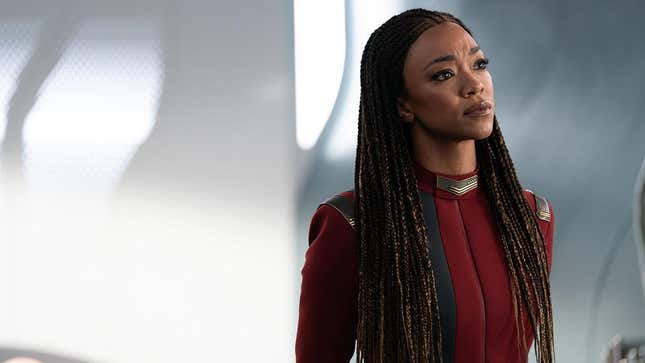
This week, Star Trek: Discovery boldly goes for one final adventure . After years of waiting—and knowing that this fifth season would be its last—the Trek show that launched the franchise’s current renaissance will begin its victory lap. But before that, it has been a while since Discovery was last on our screens—so here’s everything important to remember.
The 32nd Century Is Here to Stay
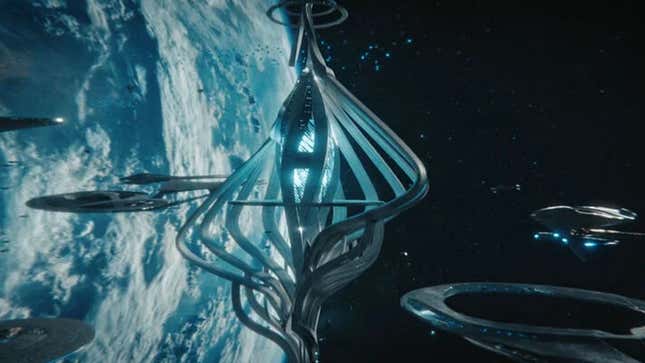
This one depends on how long you’ve been away from Discovery , really, but I’m sure there’s someone out there intrigued by the final season of a Star Trek show who’s maybe either not watched since the early days or wants to jump in on the last leg. So, if that’s you ... well, go watch the rest of the show first. It has its moments.
But if you insist: Discovery has not been the pre-original- Trek show it started out as for a long while now. At the end of season two, the crew and the Discovery itself were flung far, far into the future in order to close the loop on a potential galaxy-ending threat that meant they could never return to their original timeline in the 23rd century. Ever since, they have been at the furthest point a Star Trek show has ever consistently gone to, even beyond the far future glimpsed in Enterprise ’s Temporal Cold War storyline: the 32nd century.
Things are, to be clear, not 100% great at this moment in time, state of the galaxy-wise. Before Discovery showed up, the Federation’s myriad member worlds and Starfleet had been completely torn apart by a cataclysmic event called “The Burn,” the simultaneous detonation of dilithium across known space which rendered warp travel—and thus the existence of interstellar society as it had existed for over a thousand years—extremely difficult.
Discovery helped solve that problem, slowly but surely allowing Starfleet to rebuild, but not before it faced another cataclysmic threat called the Dark Matter Anomaly, or DMA, a not-so-random “random” gravitational event that kept showing up and destroying entire worlds in storms of debris and chaos. Turns out the DMA was actually the product of an extra-galactic race known only as the Ten-C, which, once again, Discovery helped solve the problem with after successfully making First Contact with the beings. Hopefully things calm down a bit in terms of existence-threatening cataclysms in season five!
The Vulcans and Humans Just Nearly Lost Their Homes
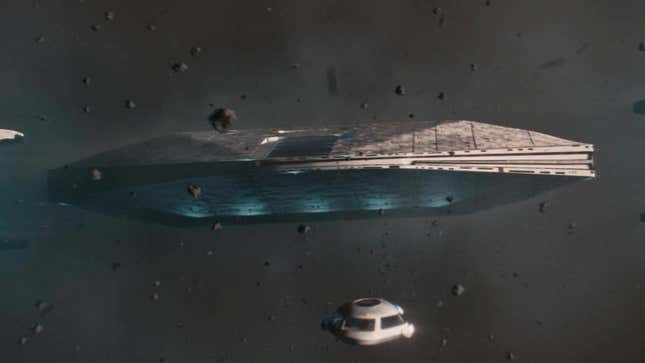
Speaking of that, Discovery ’s fourth season climaxed with both Earth and Ni’Var—the rechristened homeworld of the Vulcans and Romulans, who have been re-united as sibling peoples by the 32nd century—under the direct threat of the DMA, necessitating the almost total-evacuation of the worlds as they faced destruction from showers of debris. Thanks to Captain Burnham and the Discovery crew’s intervention, the DMA was stopped just before all this happened—and most of the populations of Earth and Ni’Var, but not all of them, had been evacuated by Starfleet.
We don’t know quite how much time has passed between the events of season four and five (it’s been over two years in reality, hence why you’re reading this catchup post), but don’t be surprised if at least some of this doesn’t get mentioned in early episodes as the universe and our heroes continue to deal with the ramifications. One of which being...
Earth Is Joining the Federation (Again)
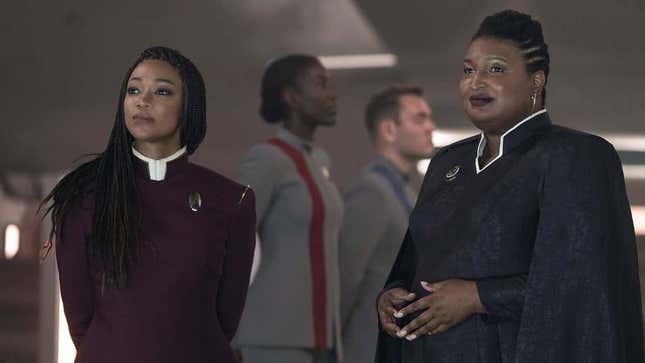
One of the final scenes of Discovery ’s fourth season saw Captain Burnham and various Federation dignitaries play host to the arrival of the President of United Earth—as the world seeks to rejoin the Federation, as a show of thanks for Starfleet’s aid during the DMA crisis. It turns out that after the events of the Burn in the time between Discovery season two and three, Earth was one of the first member worlds to secede from the Federation, transforming itself into an isolationist, inward-looking, paranoid militaristic society that remained increasingly skeptical of the Federation’s capacity to survive over the course of seasons three and four. At least, until it got to see first-hand what unity and co-operation could still do in this changed and put-upon galaxy.
Also, this probably won’t come up in season five, but we should note that the President of United Earth who engages in this process to rejoin the Federation is played by famous Georgia Democrat (and avowed Trekkie) Stacey Abrams . Please do not try to think about squaring that with everything I just said about United Earth’s political attitudes, because Discovery sure as hell didn’t.
Michael and Book Are Parting... But Not for Long

One of the more emotional fallouts of season four’s plot with the DMA was the anomaly’s destruction of the planet Kwejian—the homeworld of Cleveland “Book” Booker, played by David Ajala, the smuggler turned paramour of Captain Burnham over the course of Discovery ’s third and fourth seasons. The loss of his home drove Book to surreptitiously betray Burnham and Starfleet to work with the rogue scientist Ruon Tarka, as they worked on a way to completely dissipate the DMA even after its true nature and extragalactic origins were discovered.
Booker saw the light by the end of the season, and nearly died in the process alongside Tarka, but after being saved by the Ten-C he turned himself over to the Federation to pay for siding with Tarka—pulling from Burnham’s side and from the home he’d made with her on Discovery , and assigned to community service, aiding Federation relief efforts on Europa for families impacted by the DMA’s fallout.
Good for You, Saru
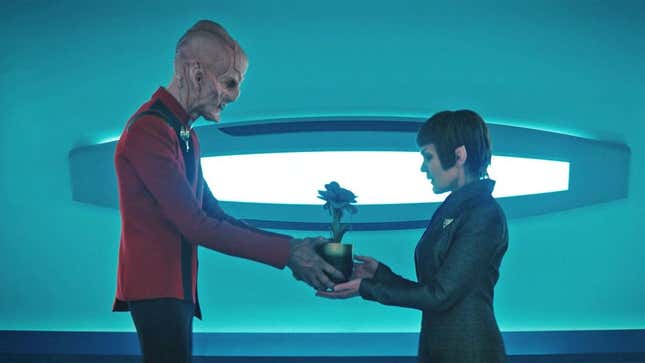
Speaking of romantic dalliances, season four played up a lingering connection between Michael’s trusted friend and first officer, Saru, and Ambassador T’Rina, Ni’Var’s representative to the Federation—and after much invites to tea and will-they-won’t-they, finally made their feelings for each other clear in the finale of season four. Presumably that means we’ll get to see a lot more of the pair together in the final season—and the interesting romantic struggles of what happens when a senior officer on a starship and a Federation ambassador start courting. Hopefully there’s a happy ending for our put-upon Kelpian hero.
One of Discovery ’s Most Unique Technologies Is No More
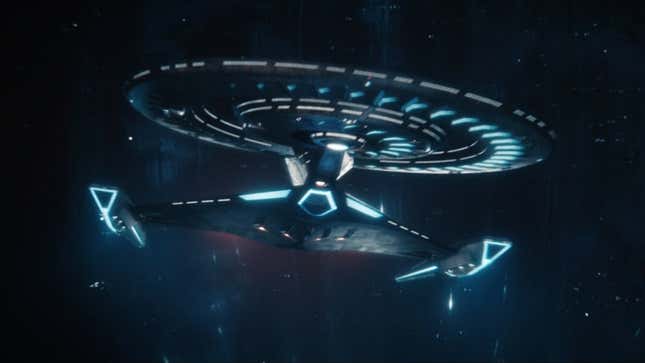
One of the major technological aspects of Discovery introduced from the very beginning was its use of a “Spore Drive”—an unprecedented method of FTL travel that allowed the ship to avoid typical warp travel and issues and instead navigate its way along a mycelial network across subspace, allowing everything from long range travel to precise realspace jumping across. The Spore Drive made Discovery unique as a ship, both in its original time when the technology was first being secretly developed and even far into the 32nd century—especially after the events of the Burn made regular long-distance FTL through warp drives impossible at scale.
But during the events of season four’s finale, both the known Spore Drives in existence—the Discovery ’s and the one implemented into Book’s ship—were sacrificed in the attempt to stop Dr. Tarka’s plans to destroy the DMA. Discovery still has traditional warp drives as a back up for the Spore Drive, but still, the loss of what became a key defining part of Discovery ’s worldbuilding will no doubt come up in season five.
Tilly’s Back
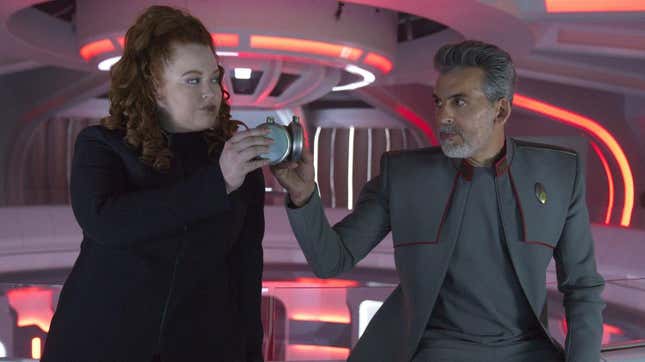
The beloved former cadet (now Lieutenant JG, by the time of season four) Sylvia Tilly shocked Discovery fans when she seemingly left the show early into the last season , when she took an offered teaching position at the re-building Starfleet Academy. While Tilly was absent for much of season four, she did return for the finale, helping Starfleet command in the evacuation of Earth, and celebrated with her former crewmates. Just how and why remains to be seen, but we do known from Tilly actress Mary Wiseman that she does indeed return to the Discovery during season five, but whatever happens, it may not be the last of Tilly we see, even as the show ends, because...
The Journey Never Ends
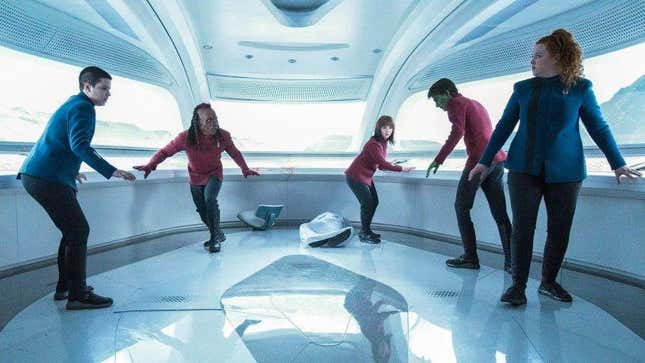
Star Trek ’s future is wide open right now , as the franchise navigates the ends of Discovery and Picard and looks to a future that balances together streaming shows, made-for-streaming movies like Section 31 and a potential Picard continuation, and multiple attempts to bring Trek back to theatrical superstardom. But one key part of that is crucial to Discovery : its exploration of the 32nd century won’t end when it does.
The one brand-new show we know is definitely still part of Trek ’s future at the moment is Starfleet Academy , set to begin filming this year, and will follow the prestigious institute during the 32nd century time period, rather than going back to the Trek eras established in other shows. That’s all we know at this point—we don’t know if Mary Wiseman could potentially be a key star for the series, or anyone else affiliated with Discovery , or even which students will be the focus of the series. But it does mean that even as Discovery bids farewell, the world it has established will keep boldly going beyond it.
Star Trek: Discovery season five premieres April 4 on Paramount+.
By providing your information, you agree to our Terms of Use and our Privacy Policy . We use vendors that may also process your information to help provide our services. This site is protected by reCAPTCHA Enterprise and the Google Privacy Policy and Terms of Service apply.
‘Star Trek’: Rachel Garrett, the First Female USS Enterprise Captain, Will Be Part of the ‘Section 31’ Movie
Christian blauvelt.
- Share on Facebook
- Share to Flipboard
- Share on LinkedIn
- Show more sharing options
- Submit to Reddit
- Post to Tumblr
- Print This Page
- Share on WhatsApp
“ Star Trek ” fans got a couple fascinating details in a March 27 report by Variety on the future of the franchise on Paramount+. The biggest for sure is that the character of Rachel Garrett, the first female captain of the USS Enterprise, will be appearing in the “Section 31” direct-to-Paramount+ movie that’s going to star Michelle Yeoh .
The actress Kacey Rohl will be playing Garrett, who was the captain of the Enterprise-C in the first half of the 24th century and was the subject of one of the most beloved “Next Generation” episodes ever: “Yesterday’s Enterprise” (she was played by Tricia O’Neal in the original episode).
This is the episode where, once they’ve agreed to face their doom, Picard says, “Let’s make sure history never forgets the name Enterprise.” If Kirk didn’t believe in a “no win” situation, she faced one head-on, making Garrett an especially valiant captain.
In the “Star Trek” timeline, she’s the first female Enterprise captain. In order, the timeline goes: Jonathan Archer of the pre-Federation Enterprise NX-01, James T. Kirk of the Enterprise NCC-1701 and Enterprise-A, Alan Ruck’s John Harriman of the Enterprise-B (this writer chooses to believe that since the lore does say Harrison came from “a prominent family,” that he is in fact a descendant of Connor Roy, thus winning the ultimate succession: the Enterprise captain’s chair), and then Garrett.
One other interesting detail emerged in that report: That the “Starfleet Academy” show, which IndieWire told you a year ago must logically have a 32nd Century setting as a follow-up series to “Discovery,” is in fact confirmed to be set then, but, surprisingly, is being targeted to a “tween and teen” audience.
Jonathan Frakes, who’s directed episodes of every “Trek” series since “Next Gen” in addition to playing Riker on that series and beyond, is quoted in the Variety piece as saying that he thinks the franchise’s audience is older. Franchise mastermind Alex Kurtzman seems to hope that a show like “Starfleet Academy” may reach a new audience altogether.
Reps for Paramount+ did not respond to IndieWire’s request for comment about confirmation of these details.
Most Popular
You may also like.

Den of Geek
The New Star Trek Movie Will Finally Explore a Missing Part of Enterprise Lore
The upcoming Star Trek movie Section 31 adds a surprising new character: Captain Rachel Garrett of the USS Enterprise-C.

- Share on Facebook (opens in a new tab)
- Share on Twitter (opens in a new tab)
- Share on Linkedin (opens in a new tab)
- Share on email (opens in a new tab)
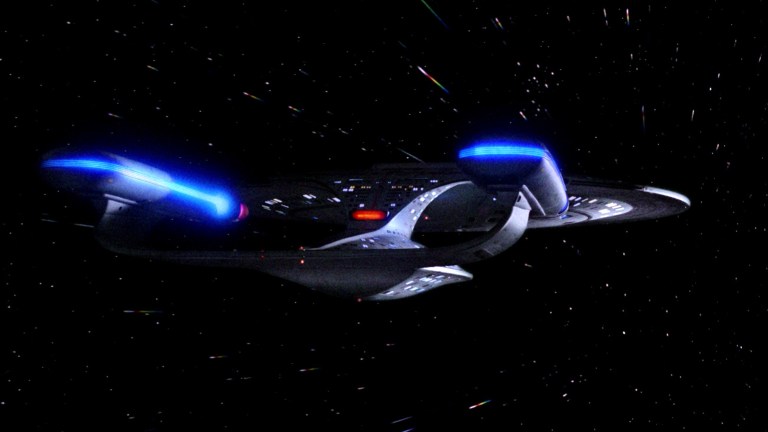
The Enterprise-C has returned! Again!
According to a Variety report about the future of the Star Trek franchise, the upcoming Section 31 movie will feature Kacey Rohl as a “young” Rachel Garrett, presumably before she became the captain of the Enterprise-C. It’s a surprising but exciting turn of events, to be sure, since Garrett has only appeared in a single episode of Star Trek , leaving much of her history yet to be explored. In fact, digging into more of Garrett’s story would be a way to unlock a piece of Star Trek captain lore that’s long been missing despite the Enterprise-C’s introduction over 30 years ago.
Fans first met an older Garrett (Tricia O’Neil) and the Enterprise-C in the season three Star Trek: The Next Generation episode “Yesterday’s Enterprise.” When that episode aired in February 1990, the arrival of the Enterprise-C addressed a question that had lingered since the show’s premiere three years earlier. Obviously, The Original Series took place on the USS Enterprise, which was destroyed in Star Trek III: The Search For Spock and replaced by the Enterprise-A at the end of Star Trek IV: The Voyage Home .
The TNG premiere “ Encounter at Farpoint ,” which is set almost a century after The Original Series , introduced the Enterprise-D. But what about the Enterprise-B and -C? The answer for the former came in Generations , which begins with the Enterprise-B’s troubled maiden voyage, and would go on to live in non-canonical stories outside of movies and television.
Ad – content continues below
But “Yesterday’s Enterprise” tells a much richer onscreen story about the Enterprise-C. Destroyed 20 years before the episode’s setting, the Enterprise-C goes through a time distortion and arrives in a changed future. In the original timeline, the -C was destroyed while attempting to rescue a Klingon outpost. When the time shift prevents the -C from completing its mission in the past, the future changes and the Federation is suddenly in the midst of a protracted war against the Klingons. In this reality, the Enterprise-D is a battleship, led by an embittered Picard and his military-focused crew, including Denise Crosby’s Tasha Yar.
Directed by David Carson and based on a story by Trent Christopher Ganino & Eric A. Stillwell, “Yesterday’s Enterprise” serves as a proper send-off for Tasha Yar, an original crew member who died an ignoble death at the “hands” of a blob monster in the season one episode “Skin of Evil.” Yar, and the crew of the Enterprise-C, choose to send the time-displaced ship back into the past and complete its deadly mission, sacrificing themselves to prevent the Federation/Klingon war from ever happening.
It’s a glorious episode, one of the best in the series, and a fitting end for Yar. However, Garrett puts in a great showing as a model Starfleet Captain too, embodying the courage and selflessness that marks the best captains. Even though she suffers a surprisingly gnarly death before her ship can go back to the past and complete its mission, Garrett remains a compelling figure from Star Trek lore.
Garrett later got a nod in Star Trek: Picard , which revealed her statue stood on M’talas Prime. But that’s all we currently know about Garrett, unless you count the non-canonical Lost Era novels The Art of the Impossible and Well of Souls , which flesh out her character. In canon, though, Garrett remains a compelling mystery.
As she demonstrated on the series Hannibal , Rohl knows a thing or two about portraying under-explored fan-favorites. On that Bryan Fuller -created adaptation of Thomas Harris’ novels, Rohl played Abigail Hobbes, the daughter of Garret Jacob Hobbs aka the Minnesota Shrike, a serial killer only mentioned in passing in Harris’ books.
Coincidentally, in Section 31 , Rohl’s Rachel Garrett will appear alongside another Fuller creation: Philippa Georgiou, played by Michelle Yeoh . As the original creator of Discovery , Fuller introduced Georgiou as Michael Burnham’s commanding officer, who dies in the Battle of the Binary Stars, only for her Mirror Universe equivalent to arrive and take her place.
The Mirror version of Yeoh’s Georgiou will be the main character of the upcoming Section 31 movie, which focuses on the secret ( and, frankly, overused ) intelligence wing of Starfleet. While she traveled to the 32nd Century with the USS Discovery at the end of that show’s third season, Georgiou’s body began to suffer from traveling across dimensions and timelines. She was forced to return to her previous time, presumably to resume work with Section 31.
Get the best of Den of Geek delivered right to your inbox!
Georgiou’s experience moving across timelines and dimensions might explain Garrett’s role in Section 31 . After all, Garrett did also cross timelines and dimensions in “Yesterday’s Enterprise,” and while she died before the effects of the journey could set in, that information would be of interest to Section 31.
However Section 31 plans to handle Garrett, her inclusion will finally shed some more light on the most mysterious of Enterprise eras. Where even the Enterprise-B lived on in non-canonical novels, comics, and video games, the Enterprise-C exists only to die. Perhaps, Section 31 and Rohl’s Rachel Garrett will give fans more to love about this doomed ship, and make sure that history never forgets the name Enterprise.
Star Trek: Section 31 is slated to release in 2025.

Joe George | @jageorgeii
Joe George’s writing has appeared at Slate, Polygon, Tor.com, and elsewhere!

Everything to Remember Before Star Trek: Discovery Returns for Its Final Season
T his week, Star Trek: Discovery boldly goes for one final adventure . After years of waiting—and knowing that this fifth season would be its last—the Trek show that launched the franchise’s current renaissance will begin its victory lap. But before that, it has been a while since Discovery was last on our screens—so here’s everything important to remember.
The 32nd Century Is Here to Stay
This one depends on how long you’ve been away from Discovery, really, but I’m sure there’s someone out there intrigued by the final season of a Star Trek show who’s maybe either not watched since the early days or wants to jump in on the last leg. So, if that’s you... well, go watch the rest of the show first. It has its moments.
But if you insist: Discovery has not been the pre-original-Trek show it started out as for a long while now. At the end of season two, the crew and the Discovery itself were flung far, far into the future in order to close the loop on a potential galaxy-ending threat that meant they could never return to their original timeline in the 23rd century. Ever since, they have been at the furthest point a Star Trek show has ever consistently gone to, even beyond the far future glimpsed in Enterprise’s Temporal Cold War storyline: the 32nd century.
Things are, to be clear, not 100% great at this moment in time, state of the galaxy-wise. Before Discovery showed up, the Federation’s myriad member worlds and Starfleet had been completely torn apart by a cataclysmic event called “The Burn,” the simultaneous detonation of dilithium across known space which rendered warp travel—and thus the existence of interstellar society as it had existed for over a thousand years—extremely difficult.
Discovery helped solve that problem, slowly but surely allowing Starfleet to rebuild, but not before it faced another cataclysmic threat called the Dark Matter Anomaly, or DMA, a not-so-random “random” gravitational event that kept showing up and destroying entire worlds in storms of debris and chaos. Turns out the DMA was actually the product of an extra-galactic race known only as the Ten-C, which, once again, Discovery helped solve the problem with after successfully making First Contact with the beings. Hopefully things calm down a bit in terms of existence-threatening cataclysms in season five!
The Vulcans and Humans Just Nearly Lost Their Homes
Speaking of that, Discovery’s fourth season climaxed with both Earth and Ni’Var—the rechristened homeworld of the Vulcans and Romulans, who have been re-united as sibling peoples by the 32nd century—under the direct threat of the DMA, necessitating the almost total-evacuation of the worlds as they faced destruction from showers of debris. Thanks to Captain Burnham and the Discovery crew’s intervention, the DMA was stopped just before all this happened—and most of the populations of Earth and Ni’Var, but not all of them, had been evacuated by Starfleet.
We don’t know quite how much time has passed between the events of season four and five (it’s been over two years in reality, hence why you’re reading this catchup post), but don’t be surprised if at least some of this doesn’t get mentioned in early episodes as the universe and our heroes continue to deal with the ramifications. One of which being...
Earth Is Joining the Federation (Again)
One of the final scenes of Discovery’s fourth season saw Captain Burnham and various Federation dignitaries play host to the arrival of the President of United Earth—as the world seeks to rejoin the Federation, as a show of thanks for Starfleet’s aid during the DMA crisis. It turns out that after the events of the Burn in the time between Discovery season two and three, Earth was one of the first member worlds to secede from the Federation, transforming itself into an isolationist, inward-looking, paranoid militaristic society that remained increasingly skeptical of the Federation’s capacity to survive over the course of seasons three and four. At least, until it got to see first-hand what unity and co-operation could still do in this changed and put-upon galaxy.
Also, this probably won’t come up in season five, but we should note that the President of United Earth who engages in this process to rejoin the Federation is played by famous Georgia Democrat (and avowed Trekkie) Stacey Abrams . Please do not try to think about squaring that with everything I just said about United Earth’s political attitudes, because Discovery sure as hell didn’t.
Michael and Book Are Parting... But Not for Long
One of the more emotional fallouts of season four’s plot with the DMA was the anomaly’s destruction of the planet Kwejian—the homeworld of Cleveland “Book” Booker, played by David Ajala, the smuggler turned paramour of Captain Burnham over the course of Discovery’s third and fourth seasons. The loss of his home drove Book to surreptitiously betray Burnham and Starfleet to work with the rogue scientist Ruon Tarka, as they worked on a way to completely dissipate the DMA even after its true nature and extragalactic origins were discovered.
Booker saw the light by the end of the season, and nearly died in the process alongside Tarka, but after being saved by the Ten-C he turned himself over to the Federation to pay for siding with Tarka—pulling from Burnham’s side and from the home he’d made with her on Discovery, and assigned to community service, aiding Federation relief efforts on Europa for families impacted by the DMA’s fallout.
Good for You, Saru
Speaking of romantic dalliances, season four played up a lingering connection between Michael’s trusted friend and first officer, Saru, and Ambassador T’Rina, Ni’Var’s representative to the Federation—and after much invites to tea and will-they-won’t-they, finally made their feelings for each other clear in the finale of season four. Presumably that means we’ll get to see a lot more of the pair together in the final season—and the interesting romantic struggles of what happens when a senior officer on a starship and a Federation ambassador start courting. Hopefully there’s a happy ending for our put-upon Kelpian hero.
One of Discovery’s Most Unique Technologies Is No More
One of the major technological aspects of Discovery introduced from the very beginning was its use of a “Spore Drive”—an unprecedented method of FTL travel that allowed the ship to avoid typical warp travel and issues and instead navigate its way along a mycelial network across subspace, allowing everything from long range travel to precise realspace jumping across. The Spore Drive made Discovery unique as a ship, both in its original time when the technology was first being secretly developed and even far into the 32nd century—especially after the events of the Burn made regular long-distance FTL through warp drives impossible at scale.
But during the events of season four’s finale, both the known Spore Drives in existence—the Discovery’s and the one implemented into Book’s ship—were sacrificed in the attempt to stop Dr. Tarka’s plans to destroy the DMA. Discovery still has traditional warp drives as a back up for the Spore Drive, but still, the loss of what became a key defining part of Discovery’s worldbuilding will no doubt come up in season five.
Tilly’s Back
The beloved former cadet (now Lieutenant JG, by the time of season four) Sylvia Tilly shocked Discovery fans when she seemingly left the show early into the last season , when she took an offered teaching position at the re-building Starfleet Academy. While Tilly was absent for much of season four, she did return for the finale, helping Starfleet command in the evacuation of Earth, and celebrated with her former crewmates. Just how and why remains to be seen, but we do known from Tilly actress Mary Wiseman that she does indeed return to the Discovery during season five, but whatever happens, it may not be the last of Tilly we see, even as the show ends, because...
The Journey Never Ends
Star Trek’s future is wide open right now , as the franchise navigates the ends of Discovery and Picard and looks to a future that balances together streaming shows, made-for-streaming movies like Section 31 and a potential Picard continuation, and multiple attempts to bring Trek back to theatrical superstardom. But one key part of that is crucial to Discovery: its exploration of the 32nd century won’t end when it does.
The one brand-new show we know is definitely still part of Trek’s future at the moment is Starfleet Academy , set to begin filming this year, and will follow the prestigious institute during the 32nd century time period, rather than going back to the Trek eras established in other shows. That’s all we know at this point—we don’t know if Mary Wiseman could potentially be a key star for the series, or anyone else affiliated with Discovery, or even which students will be the focus of the series. But it does mean that even as Discovery bids farewell, the world it has established will keep boldly going beyond it.
Star Trek: Discovery season five premieres April 4 on Paramount+.
For the latest news, Facebook , Twitter and Instagram .
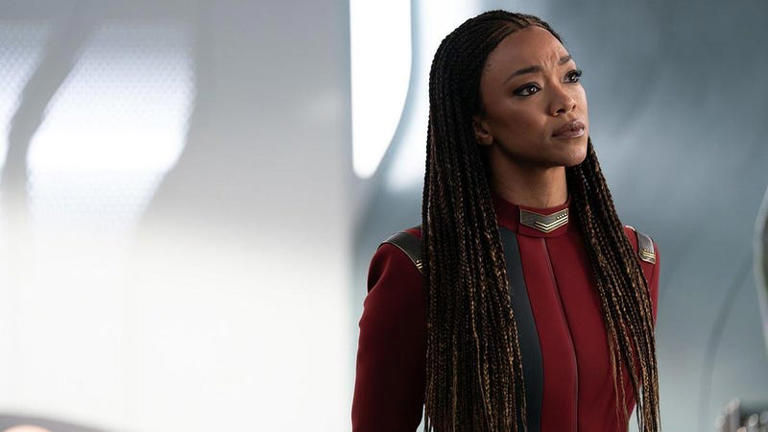
The Future of ‘Star Trek’: From ‘Starfleet Academy’ to New Movies and Michelle Yeoh, How the 58-Year-Old Franchise Is Planning for the Next Generation of Fans
“I can’t believe I get to play the captain of the Enterprise.”
“Strange New Worlds” is the 12th “Star Trek” TV show since the original series debuted on NBC in 1966, introducing Gene Roddenberry’s vision of a hopeful future for humanity. In the 58 years since, the “Star Trek” galaxy has logged 900 television episodes and 13 feature films, amounting to 668 hours — nearly 28 days — of content to date. Even compared with “Star Wars” and the Marvel Cinematic Universe, “Star Trek” stands as the only storytelling venture to deliver a single narrative experience for this long across TV and film.
In other words, “Star Trek” is not just a franchise. As Alex Kurtzman , who oversees all “Star Trek” TV production, puts it, “‘Star Trek’ is an institution.”
Without a steady infusion of new blood, though, institutions have a way of fading into oblivion (see soap operas, MySpace, Blockbuster Video). To keep “Star Trek” thriving has meant charting a precarious course to satisfy the fans who have fueled it for decades while also discovering innovative ways to get new audiences on board.
“Doing ‘Star Trek’ means that you have to deliver something that’s entirely familiar and entirely fresh at the same time,” Kurtzman says.
The franchise has certainly weathered its share of fallow periods, most recently after “Nemesis” bombed in theaters in 2002 and UPN canceled “Enterprise” in 2005. It took 12 years for “Star Trek” to return to television with the premiere of “Discovery” in 2017; since then, however, there has been more “Star Trek” on TV than ever: The adventure series “Strange New Worlds,” the animated comedy “Lower Decks” and the kids series “Prodigy” are all in various stages of production, and the serialized thriller “Picard” concluded last year, when it ranked, along with “Strange New Worlds,” among Nielsen’s 10 most-watched streaming original series for multiple weeks. Nearly one in five Paramount+ subscribers in the U.S. is watching at least one “Star Trek” series, according to the company, and more than 50% of fans watching one of the new “Trek” shows also watch at least two others. The new shows air in 200 international markets and are dubbed into 35 languages. As “Discovery” launches its fifth and final season in April, “Star Trek” is in many ways stronger than it’s ever been.
“’Star Trek’s fans have kept it alive more times than seems possible,” says Eugene Roddenberry, Jr., who executive produces the TV series through Roddenberry Entertainment. “While many shows rightfully thank their fans for supporting them, we literally wouldn’t be here without them.”
But the depth of fan devotion to “Star Trek” also belies a curious paradox about its enduring success: “It’s not the largest fan base,” says Akiva Goldsman, “Strange New Worlds” executive producer and co-showrunner. “It’s not ‘Star Wars.’ It’s certainly not Marvel.”
When J.J. Abrams rebooted “Star Trek” in 2009 — with Chris Pine, Zachary Quinto and Zoe Saldaña playing Kirk, Spock and Uhura — the movie grossed more than any previous “Star Trek” film by a comfortable margin. But neither that film nor its two sequels broke $500 million in global grosses, a hurdle every other top-tier franchise can clear without breaking a sweat.
There’s also the fact that “Star Trek” fans are aging. I ask “The Next Generation” star Jonathan Frakes, who’s acted in or directed more versions of “Star Trek” than any other person alive, how often he meets fans for whom the new “Star Trek” shows are their first. “Of the fans who come to talk to me, I would say very, very few,” he says. “‘Star Trek’ fans, as we know, are very, very, very loyal — and not very young.”
As Stapf puts it: “There’s a tried and true ‘Trek’ fan that is probably going to come to every ‘Star Trek,’ no matter what it is — and we want to expand the universe.”
Every single person I spoke to for this story talked about “Star Trek” with a joyful earnestness as rare in the industry as (nerd alert) a Klingon pacifist.
“When I’m meeting fans, sometimes they’re coming to be confirmed, like I’m kind of a priest,” Ethan Peck says during a break in filming on the “Strange New Worlds” set. He’s in full Spock regalia — pointy ears, severe eyebrows, bowl haircut — and when asked about his earliest memories of “Star Trek,” he stares off into space in what looks like Vulcan contemplation. “I remember being on the playground in second or third grade and doing the Vulcan salute, not really knowing where it came from,” he says. “When I thought of ‘Star Trek,’ I thought of Spock. And now I’m him. It’s crazy.”
To love “Star Trek” is to love abstruse science and cowboy diplomacy, complex moral dilemmas and questions about the meaning of existence. “It’s ultimately a show with the most amazing vision of optimism, I think, ever put on-screen in science fiction,” says Kurtzman, who is 50. “All you need is two minutes on the news to feel hopeless now. ‘Star Trek’ is honestly the best balm you could ever hope for.”
I’m getting a tour of the USS Enterprise from Scotty — or, rather, “Strange New World” production designer Jonathan Lee, who is gushing in his native Scottish burr as we step into the starship’s transporter room. “I got such a buzzer from doing this, I can’t tell you,” he says. “I actually designed four versions of it.”
Lee is especially proud of the walkway he created to run behind the transporter pads — an innovation that allows the production to shoot the characters from a brand-new set of angles as they beam up from a far-flung planet. It’s one of the countless ways that this show has been engineered to be as cinematic as possible, part of Kurtzman’s overall vision to make “Star Trek” on TV feel like “a movie every week.”
Kurtzman’s tenure with “Star Trek” began with co-writing the screenplay for Abrams’ 2009 movie, which was suffused with a fast-paced visual style that was new to the franchise. When CBS Studios approached Kurtzman in the mid-2010s about bringing “Star Trek” back to TV, he knew instinctively that it needed to be just as exciting as that film.
“The scope was so much different than anything we had ever done on ‘Next Gen,’” says Frakes, who’s helmed two feature films with the “Next Generation” cast and directed episodes of almost every live-action “Trek” TV series, including “Discovery” and “Strange New Worlds.” “Every department has the resources to create.”
A new science lab set for Season 3, for example, boasts a transparent floor atop a four-foot pool of water that swirls underneath the central workbench, and the surrounding walls sport a half dozen viewscreens with live schematics custom designed by a six-person team. “I like being able to paint on a really big canvas,” Kurtzman says. “The biggest challenge is always making sure that no matter how big something gets, you’re never losing focus on that tiny little emotional story.”
At this point, is there a genre that “Strange New Worlds” can’t do? “As long as we’re in storytelling that is cogent and sure handed, I’m not sure there is,” Goldsman says with an impish smile. “Could it do Muppets? Sure. Could it do black and white, silent, slapstick? Maybe!”
This approach is also meant to appeal to people who might want to watch “Star Trek” but regard those 668 hours of backstory as an insurmountable burden. “You shouldn’t have to watch a ‘previously on’ to follow our show,” Myers says.
To achieve so many hairpin shifts in tone and setting while maintaining Kurtzman’s cinematic mandate, “Strange New Worlds” has embraced one of the newest innovations in visual effects: virtual production. First popularized on the “Star Wars” series “The Mandalorian,” the technology — called the AR wall — involves a towering circular partition of LED screens projecting a highly detailed, computer-generated backdrop. Rather than act against a greenscreen, the actors can see whatever fantastical surroundings their characters are inhabiting, lending a richer level of verisimilitude to the show.
But there is a catch. While the technology is calibrated to maintain a proper sense of three-dimensional perspective through the camera lens, it can be a bit dizzying for anyone standing on the set. “The images on the walls start to move in a way that makes no sense,” says Mount. “You end up having to focus on something that’s right in front of you so you don’t fall down.”
And yet, even as he’s talking about it, Mount can’t help but break into a boyish grin. “Sometimes we call it the holodeck,” he says. In fact, the pathway to the AR wall on the set is dotted with posters of the virtual reality room from “The Next Generation” and the words “Enter Holodeck” in a classic “Trek” font.
“I want to take one of those home with me,” Peck says. Does the AR wall also affect him? “I don’t really get disoriented by it. Spock would not get ill, so I’m Method acting.”
I’m on the set of the “Star Trek” TV movie “Section 31,” seated in an opulent nightclub with a view of a brilliant, swirling nebula, watching Yeoh rehearse with director Olatunde Osunsanmi and her castmates. Originally, the project was announced as a TV series centered on Philippa Georgiou, the semi-reformed tyrant Yeoh originated on “Discovery.” But between COVID delays and the phenomenon of “Everything Everywhere All at Once,” there wasn’t room in the veteran actress’s schedule to fit a season of television. Yeoh was undaunted.
“We’d never let go of her,” she says of her character. “I was just blown away by all the different things I could do with her. Honestly, it was like, ‘Let’s just get it done, because I believe in this.’”
If that means nothing to you, don’t worry: The enormity of the revelation that Garrett is being brought back is meant only for fans. If you don’t know who the character is, you’re not missing anything.
“It was always my goal to deliver an entertaining experience that is true to the universe but appeals to newcomers,” says screenwriter Craig Sweeny. “I wanted a low barrier of entry so that anybody could enjoy it.”
Nevertheless, including Garrett on the show is exactly the kind of gasp-worthy detail meant to flood “Star Trek” fans with geeky good feeling.
“You cannot create new fans to the exclusion of old fans,” Kurtzman says. “You must serve your primary fan base first and you must keep them happy. That is one of the most important steps to building new fans.”
On its face, that maxim would make “Section 31” a genuine risk. The titular black-ops organization has been controversial with “Star Trek” fans since it was introduced in the 1990s. “The concept is almost antagonistic to some of the values of ‘Star Trek,’” Sweeny says. But he still saw “Section 31” as an opportunity to broaden what a “Star Trek” project could be while embracing the radical inclusivity at the heart of the franchise’s appeal.
“Famously, there’s a spot for everybody in Roddenberry’s utopia, so I was like, ‘Well, who would be the people who don’t quite fit in?’” he says. “I didn’t want to make the John le Carré version, where you’re in the headquarters and it’s backbiting and shades of gray. I wanted to do the people who were at the edges, out in the field. These are not people who necessarily work together the way you would see on a ‘Star Trek’ bridge.”
For Osunsanmi, who grew up watching “The Next Generation” with his father, it boils down to a simple question: “Is it putting good into the world?” he asks. “Are these characters ultimately putting good into the world? And, taking a step back, are we putting good into the world? Are we inspiring humans watching this to be good? That’s for me what I’ve always admired about ‘Star Trek.’”
Should “Section 31” prove successful, Yeoh says she’s game for a sequel. And Kurtzman is already eyeing more opportunities for TV movies, including a possible follow-up to “Picard.” The franchise’s gung-ho sojourn into streaming movies, however, stands in awkward contrast to the persistent difficulty Paramount Pictures and Abrams’ production company Bad Robot have had making a feature film following 2016’s “Star Trek Beyond” — the longest theaters have gone without a “Star Trek” movie since Paramount started making them.
First, a movie reuniting Pine’s Capt. Kirk with his late father — played in the 2009 “Star Trek” by Chris Hemsworth — fell apart in 2018. Around the same time, Quentin Tarantino publicly flirted with, then walked away from, directing a “Star Trek” movie with a 1930s gangster backdrop. Noah Hawley was well into preproduction on a “Star Trek” movie with a brand-new cast, until then-studio chief Emma Watts abruptly shelved it in 2020. And four months after Abrams announced at Paramount’s 2022 shareholders meeting that his 2009 cast would return for a movie directed by Matt Shakman (“WandaVision”), Shakman left the project to make “The Fantastic Four” for Marvel. (It probably didn’t help that none of the cast had been approached before Abrams made his announcement.)
The studio still intends to make what it’s dubbed the “final chapter” for the Pine-Quinto-Saldaña cast, and Steve Yockey (“The Flight Attendant”) is writing a new draft of the script. Even further along is another prospective “Star Trek” film written by Seth Grahame-Smith (“Abraham Lincoln: Vampire Hunter”) and to be directed by Toby Haynes (“Andor,” “Black Mirror: USS Callister”) that studio insiders say is on track to start preproduction by the end of the year. That project will serve as an origin story of sorts for the main timeline of the entire franchise. In both cases, the studio is said to be focused on rightsizing the budgets to fit within the clear box office ceiling for “Star Trek” feature films.
Far from complaining, everyone seems to relish the challenge. Visual effects supervisor Jason Zimmerman says that “working with Alex, the references are always at least $100 million movies, if not more, so we just kind of reverse engineer how do we do that without having to spend the same amount of money and time.”
The workload doesn’t seem to faze him either. “Visual effects people are a big, big ‘Star Trek’ fandom,” he says. “You naturally just get all these people who go a little bit above and beyond, and you can’t trade that for anything.”
In one of Kurtzman’s several production offices in Toronto, he and production designer Matthew Davies are scrutinizing a series of concept drawings for the newest “Star Trek” show, “Starfleet Academy.” A bit earlier, they showed me their plans for the series’ central academic atrium, a sprawling, two-story structure that will include a mess hall, amphitheater, trees, catwalks, multiple classrooms and a striking view of the Golden Gate Bridge in a single, contiguous space. To fit it all, they plan to use every inch of Pinewood Toronto’s 45,900 square foot soundstage, the largest in Canada.
But this is a “Star Trek” show, so there do need to be starships, and Kurtzman is discussing with Davies about how one of them should look. The issue is that “Starfleet Academy” is set in the 32nd century, an era so far into the future Kurtzman and his team need to invent much of its design language.
“For me, this design is almost too Klingon,” Kurtzman says. “I want to see the outline and instinctively, on a blink, recognize it as a Federation ship.”
The time period was first introduced on Season 3 of “Discovery,” when the lead character, Michael Burnham (Sonequa Martin-Green), transported the namesake starship and its crew there from the 23rd century. “It was exciting, because every time we would make a decision, we would say, ‘And now that’s canon,’” says Martin-Green.
“We listened to a lot of it,” Kurtzman says. “I think I’ve been able to separate the toxic fandom from really true fans who love ‘Star Trek’ and want you to hear what they have to say about what they would like to see.”
By Season 2, the “Discovery” writers pivoted from its dour, war-torn first season and sent the show on its trajectory 900-plus years into the future. “We had to be very aware of making sure that Spock was in the right place and that Burnham’s existence was explained properly, because she was never mentioned in the original series,” says executive producer and showrunner Michelle Paradise. “What was fun about jumping into the future is that it was very much fresh snow.”
That freedom affords “Starfleet Academy” far more creative latitude while also dramatically reducing how much the show’s target audience of tweens and teens needs to know about “Star Trek” before watching — which puts them on the same footing as the students depicted in the show. “These are kids who’ve never had a red alert before,” Noga Landau, executive producer and co-showrunner, says. “They never had to operate a transporter or be in a phaser fight.”
In the “Starfleet Academy” writers’ room in Secret Hideout’s Santa Monica offices, Kurtzman tells the staff — a mix of “Star Trek” die-hards, part-time fans and total newbies — that he wants to take a 30,000-foot view for a moment. “I think we need to ground in science more throughout the show,” he says, a giant framed photograph of Spock ears just over his shoulder. “The kids need to use science more to solve problems.”
Immediately, one of the writers brightens. “Are you saying we can amp up the techno-babble?” she says. “I’m just excited I get to use my computer science degree.”
After they break for lunch, Kurtzman is asked how much longer he plans to keep making “Star Trek.”
“The minute I fall out of love with it is the minute that it’s not for me anymore. I’m not there yet,” he says. “To be able to build in this universe to tell stories that are fundamentally about optimism and a better future at a time when the world seems to be falling apart — it’s a really powerful place to live every day.”
More From Our Brands
Netanyahu says ‘unintentional’ israeli airstrike killed aid workers in gaza, sagamore spirit’s new rye whiskey is a deconstructed manhattan in a bottle, silver lake taking endeavor private with mubadala, dell investment, the best loofahs and body scrubbers, according to dermatologists, tvline items: suits rewatch podcast, tic tac dough reboot and more, verify it's you, please log in.

USS Stargazer (NCC-82893)
- View history
The USS Stargazer (NCC-82893) was a Sagan -class Federation starship operated by Starfleet in the early 25th century . It was the third starship to bear the name Stargazer and the first of its class of ships to be equipped with components derived from research on the Borg technology of the Artifact .
- 2 Alternate timeline
- 3 Command crew
- 4.1 Appearances
- 4.2 Background information
- 4.3 Apocrypha
- 4.4 External link
History [ ]
Having helped save Coppelius from a Romulan attack in 2399 , Cristóbal Rios subsequently received a promotion to Captain upon his return to Starfleet and command of the Stargazer .
In 2401 , the Stargazer was assigned to investigate a recently appeared spatial anomaly . After picking up Doctor Agnes Jurati from Raritan IV , the Stargazer raced to the anomaly and found La Sirena and Seven of Nine already there. Shortly after, the anomaly began broadcasting a message pleading for help from Admiral Jean-Luc Picard . When Picard arrived and responded, the massive Singularity emerged from the anomaly.
The Borg announced their intention to send their Queen for negotiations. Rios was unwilling to allow her aboard his ship, but the Borg ship's transporter beam penetrated the Stargazer 's shields and materialized the Queen on the bridge . Stating that she first needed "power", the Queen began assimilating the Stargazer by taking advantage of its Borg-derived technology. Using the ship as a hub, she was also able to obtain command codes for the entire Starfleet armada reinforcing the Stargazer . With their hand phasers useless against the Queen, Picard saw no choice but to activate the Stargazer 's self-destruct before she gained total control. ( PIC : " The Star Gazer ")
Moments before the explosion, after being returned from 2024 by Q , Picard stopped the auto destruct, recognizing the Queen as the same one who had merged with Dr. Agnes Jurati in 2024. On Picard's order, the Borg Queen was allowed to coordinate the fleet and her own ship to use their shields to block an approaching energy wave that threatened millions of lives. With Rios having chosen to remain in 2024, Picard gave Seven of Nine a field commission to the rank of captain and command of the Stargazer for the mission. ( PIC : " Farewell ") Seven subsequently became the first officer of the USS Titan -A rather than remaining in command of the Stargazer . ( PIC : " The Next Generation ")
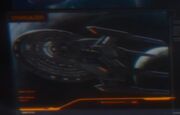
Stargazer in 2401
Later that year, the Stargazer was still in service as seen on a La Sirena display screen. ( PIC : " The Next Generation ")
The Titan -A's commanding officer, Captain Liam Shaw , learned of the Stargazer 's encounter with the Borg and considered it "weird shit". ( PIC : " No Win Scenario ")
In April of that year, the Stargazer participated in Frontier Day celebrations near Sol Station . Along with the rest of the fleet, it was seized by the Borg Collective after its younger crew were assimilated by a Borg signal transmitted via Jack Crusher . ( PIC : " Vox ") It survived the subsequent attack by the Titan -A that was aimed at buying Earth more time. Along with the rest of the fleet, the Stargazer was freed of Borg control when the USS Enterprise -D rescued Jack and destroyed the Borg cube that was transmitting the command signal. ( PIC : " The Last Generation ")
Alternate timeline [ ]
In an alternate timeline , the Stargazer was destroyed by the auto-destruct, but Q transported several crewmembers into the Confederation of Earth timeline. ( PIC : " The Star Gazer ", " Penance ")
Command crew [ ]

Cristóbal Rios in command, 2401

Seven of Nine in command, 2401
- Cristóbal Rios (2401)
- Seven of Nine (2401) (acting)
Appendices [ ]
Appearances [ ].
- " The Star Gazer "
- " Farewell "
- " The Next Generation " (picture)
Background information [ ]
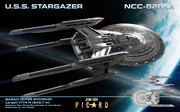
Promotional image of the Sagan -class Stargazer
The dialogue about this Stargazer in " The Star Gazer " was slightly confusing: although Jean-Luc Picard says the ship he was captain of was "not this Stargazer ", he also refers to the ship as a refit , which traditionally would refer to an older ship being rebuilt with new technology. In an interview with TrekMovie.com, Star Trek: Picard showrunner Terry Matalas was asked whether the new Stargazer was an entirely new ship, or a refit of Picard's original Stargazer . He said:
The observation lounge on the Stargazer contained models of three ships: the Radiant -class Stargazer , Picard's Constellation -class Stargazer , and Rios' Sagan -class ship.
The Stargazer is the second ship to pass from Rios to Seven of Nine, following La Sirena .
Apocrypha [ ]
In Star Trek: Picard - Stargazer , It is revealed that the Andorian Mekara ( β ) had taken command of the Stargazer .
External link [ ]
- USS Stargazer (NCC-82893) at Memory Beta , the wiki for licensed Star Trek works
- 2 USS Enterprise (NCC-1701-G)
- 3 Star Trek: The Next Generation
- More to Explore
- Series & Movies
Published Apr 2, 2024
The Final Frontier in Flavorful Coffee is Here
Pop Culture Coffee boldly launches new Star Trek coffee brand for fans and coffee connoisseurs alike!
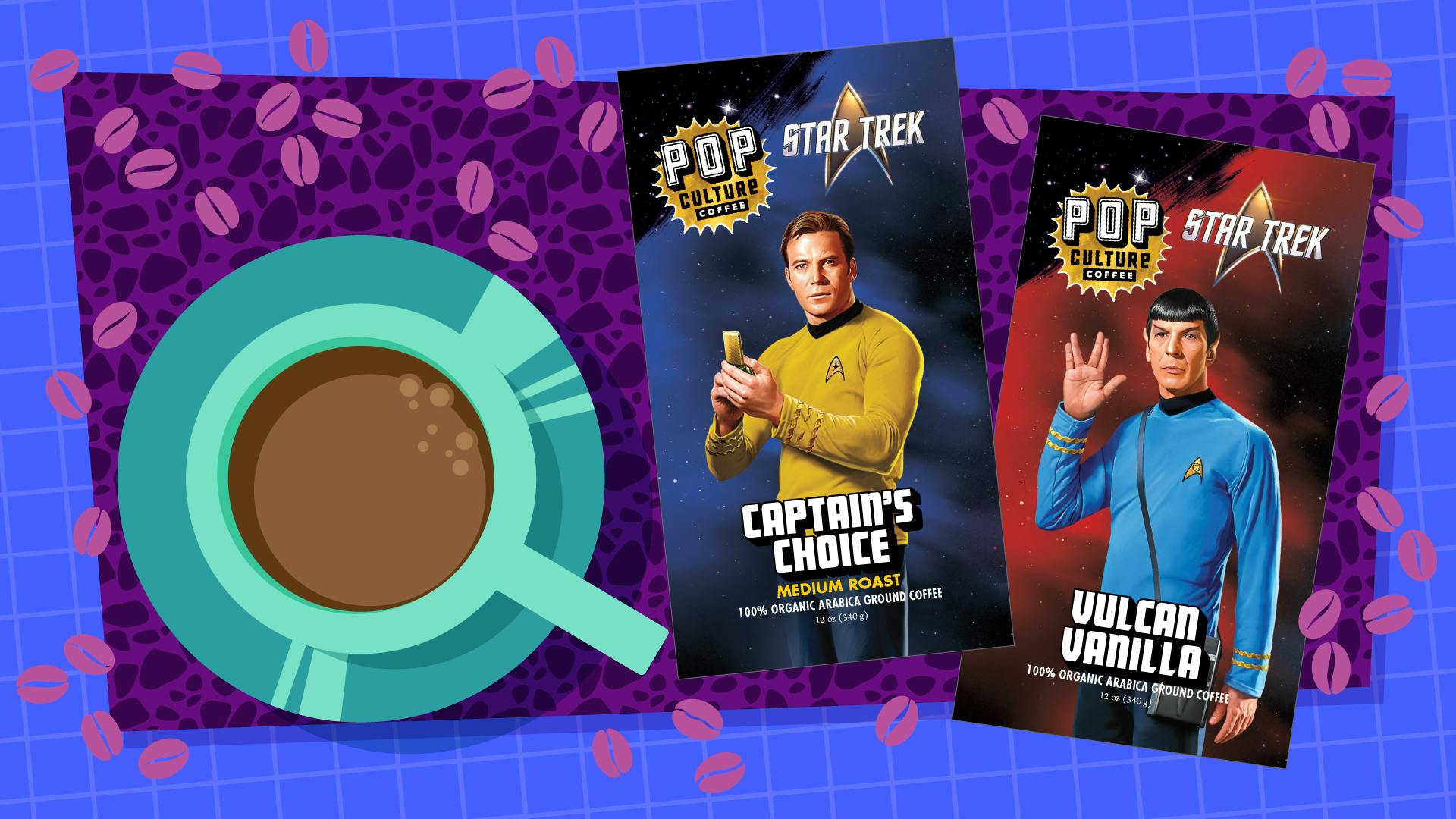
StarTrek.com
Pop Culture Coffee , an innovative new company with unique collaborations with popular franchises, has announced the launch of its highly anticipated Star Trek branded coffees. This extraordinary collection, made under license from Paramount Consumer Products, aims to cater to coffee connoisseurs, Star Trek fans, and collectors alike, bringing together the love for the beloved franchise and the art of brewing the perfect cup of coffee. Customers can purchase the official Star Trek coffee in the U.S. directly from www.popculturecoffee.com , and the product will also be available soon at select specialty retailers and conventions nationwide.
The new Star Trek branded coffees by Pop Culture Coffee seek to celebrate the spirit of the legendary franchise by offering a flavorful array of carefully curated coffee blends inspired by the various aspects of the Star Trek universe. Each of the limited-run collectible coffee blends is adorned with stunning artwork featuring iconic Star Trek characters, cultures, and starships.

Pop Culture Coffee
Launching first will be CAPTAIN’S CHOICE — a smooth medium roast featuring The Original Series ' Captain James T. Kirk on the bag, as well as VULCAN VANILLA — a full-flavored Madagascar vanilla roast featuring Mr. Spock.
Following up will be a dark KLINGON RAKTAJINO brown sugar roast, featuring The Next Generation 's Worf. Not far behind, and to celebrate First Contact Day, will be the FEDERATION FRENCH ROAST featuring Captain Jean-Luc Picard and a light BORG BEANS roast highlighting the Borg Queen from Star Trek: First Contact on the bag. More coffee profiles will be released throughout the year.
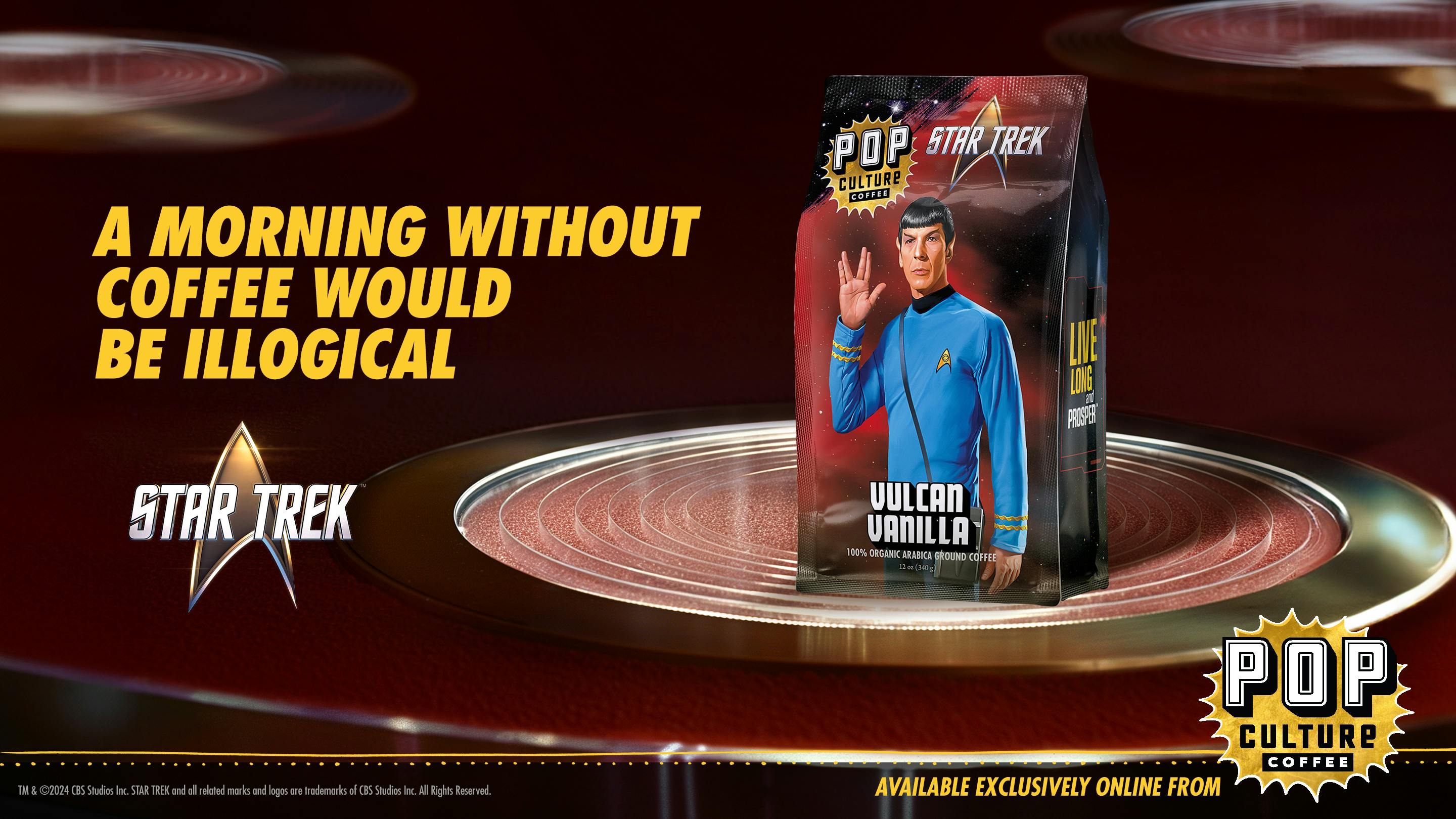
But it's not just about the packaging — Pop Culture Coffee is committed to delivering an exceptional coffee experience. All of the company’s coffees are triple-picked by hand, ethically sourced from unique origins all over the world, 100% organic Arabica beans, and small-batch craft roasted to ensure a rich and flavorful cup of coffee with every brew. Beyond the cup, Pop Culture Coffee has an entire department dedicated to meticulously pairing natural flavors for explosive great-tasting flavor-fusions. The end result? Fans will have the opportunity to enhance their coffee-drinking experience while showcasing their love for Star Trek .
Pop Culture Coffee’s founder Ethan Terra shares his vision behind the creation of Pop Culture Coffee, "My lifelong passion for movies, pop culture, collectibles, and coffee led me to establish Pop Culture Coffee. We are driven by a singular purpose — to fuel people’s passions. Whether it’s art, movies, anime, music, gaming, sports, or celebrity icons, we all have something we’re enthusiastic about, and that enthusiasm should be championed. In a world where millions rely on coffee to kick start their day, we believe that coffee should be nothing short of extraordinary."
With its fusion of sci-fi fandom and coffee culture, Pop Culture Coffee is set TO BOLDLY GO WHERE NO ONE HAS GONE BEFORE. Pop Culture Coffee invites coffee connoisseurs, fans, and collectors alike to embark on a journey of taste and imagination, bringing together two passions in a truly innovative and enjoyable way. So grab a mug, set your tastebuds to stunned, and indulge in the flavors of the Star Trek universe with every sip.
Get Updates By Email
- Food and Drink
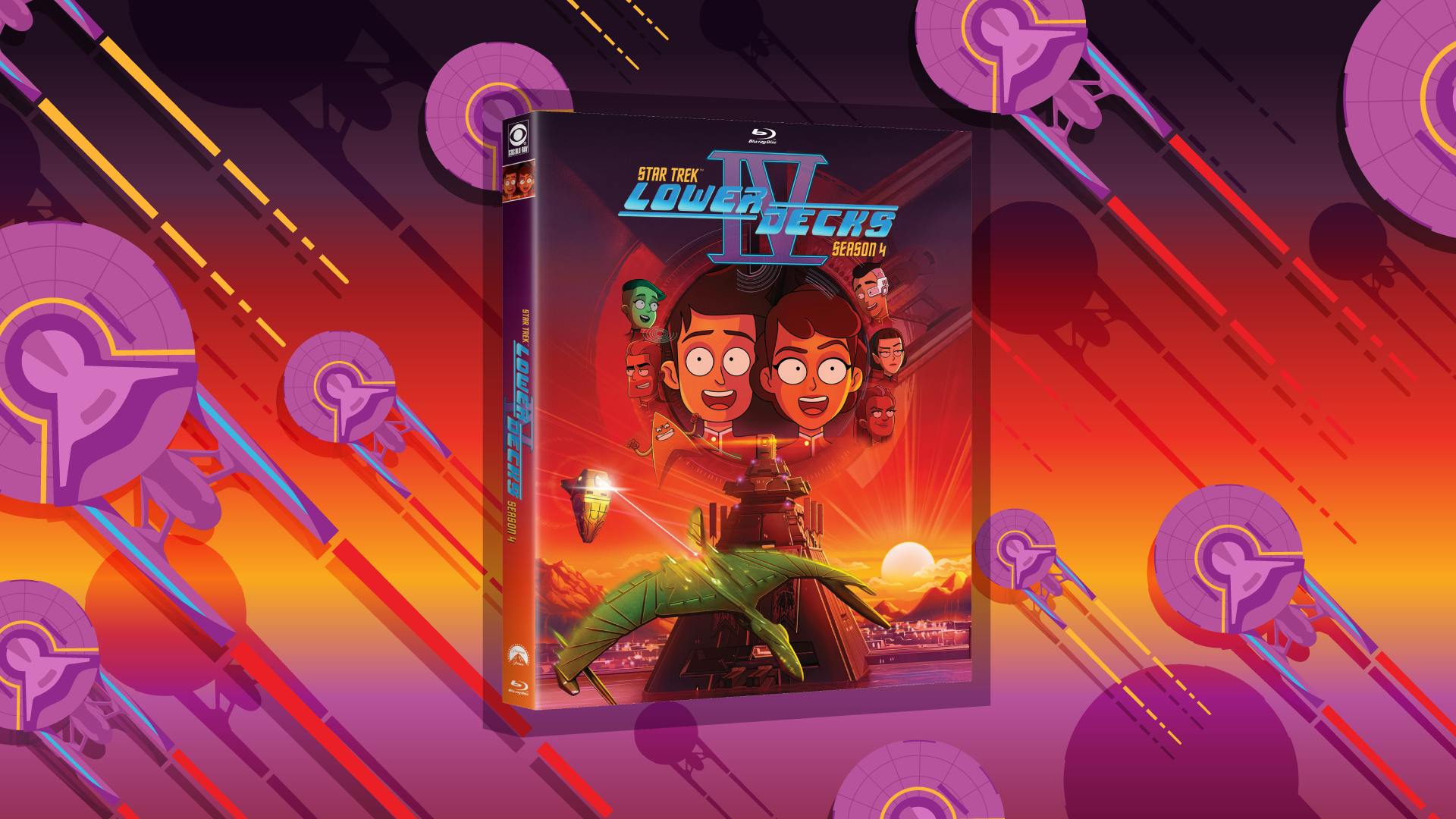

IMAGES
VIDEO
COMMENTS
Four Sutherland-Class Starships Join Star Trek: Picard's Fleet. There are four Sutherland-class starships among the fleet; the USS Almagest (NCC-91870), the USS Huygens (NCC-91814), the Ibn al-Haytham (NCC-91965), and the USS Sutherland (NCC-91800). This class was designed for the Star Trek Online game, where it was described as a variation of ...
Sci-fi. Star Trek. The Confederation of Earth was a government, described as an "xenophobic authoritarian regime" or "xenophobic tyranny", that existed on Earth after the entity Q went back in time and changed Human history. The entity Q time-traveled to the year 2024, where he altered Earth's past by ensuring...
Here are all the starships (and shuttles) in Star Trek: Picard Season One (in order of appearance). 16. USS Enterprise NCC-1701-D. CBS. The first ship to appear in Star Trek: Picard is ...
Star Trek Picard expanded the fleet of the Star Trek universe with quite a wide variety of ships, including a heroic Borg Cube, giant space flowers, and an impressive expansion of Romulan starship design. I thought it would be fun to have a look back through all the ships featured; so continue below starships fans: Picard is the only Trek TV series apart from DS9 not to have its primary ...
The following is a list of starship classes operated by the Federation. Because of the strong connotations with the real world United States Navy, Star Trek: The Original Series Producers Gene Roddenberry and Robert H. Justman (a World War II navy veteran himself) had imbued Starfleet with (The Making of Star Trek, p. 112, et al.; These Are the Voyages: TOS Season One, 1st ed, pp. 28-29; see ...
The U.S.S. Enterprise-C remains the most well known Ambassador-class vessel due to its namesake, its prominence in the classic "Yesterday's Enterprise," and its valiant rescue of the Klingon outpost on Narendra III from Romulan aggressors.Variants of this starship also notably appeared in Captain Picard's blockade during the Klingon Civil War, at the Battle of Wolf 359, and as a transport ...
In the context of Star Trek: Picard, this is the second time a historical mariner and sailor's name has been given to a starship. Rios' ill-fated ship, the USS Ibn Mājid , was named for 13th ...
Star Trek: Picard Season 3, Episode 6 sees the Titan heading for Daystrom Station, an off-the-books location housing dangerous Starfleet artifacts. However, Starfleet, compromised by the ...
Picard in the sole chair in the alternate timeline. In an alternate timeline 2366, in which the United Federation of Planets was at war with the Klingon Empire, the Enterprise-D was the Federation's first Galaxy-class warship.It featured 42 decks and was capable of transporting over 6,000 troops. Though the vessel's exterior appearance was similar if not identical to that of the vessel in the ...
In the Season 2 premiere of Star Trek: Picard, "The Star Gazer," a huge Federation fleet arrives to tango with a bizarre new Borg craft, and the ships in this fleet are instantly recognizable ...
The series and films set in this era, namely Star Trek: The Next Generation, Star Trek: Deep Space Nine, Star Trek: Voyager, Star Trek: Picard, and the four movies helmed by the TNG crew, produced vast fleets that demonstrated the Federation's prestigious shipbuilding capabilities. Narrowing down choices, and ranking my favorites proved ...
Polar Lights 1/350 Star Trek TOS USS Enterprise Saucer Section. Price $129.95. Excluding Sales Tax. ... USS TOUSSAINT Star Trek PICARD Eaglemoss. Price $129.95. Excluding Sales Tax. Quick View. USS ZHENG HE. Price $109.95. Excluding Sales Tax. Quick View. Star Trek The Official Starships Collection | U.S.S. Bonchune Nebula-Class XL Ed. Price ...
October has been a big month for fans of the Star Trek Official Starships Collection model series, with a great deal of new announcements for new starships being readied for the ever-growing armada! Starting off is the biggest news for the long-running model series: with the end of the subscription-level monthly releases at Issue #180 — the Star Trek: First Contact-era Borg Cube — the ...
Finale of Star Trek Picard, when all federation starships arrive against romulans while romulans were preparing to destroy synthetic humanoid robot's planet ...
Star Trek's ships are characters as beloved by fans as Kirk, Picard, Janeway, etc. These are the 12 most important ships in Federation history, ranked.
You say you are a Federation ship. Are you a Starfleet vessel?Telek R'Mor The Federation operated numerous varieties of starships. While the Prime Directive was observed aboard Starfleet vessels, this was not true of civilian ships. (TNG: "Angel One") Unnamed Federation starships Star Trek Ships: Expanded - UFP: Starfleet and Prehistory at The STArchive
The USS Stargazer NCC-2893 was a Federation Constellation-class starship operated by Starfleet during the 23rd century. Among its most-notable crew members was Lt. Commander Jean-Luc Picard, who spent 22 years aboard the ship, rising through the ranks from bridge officer to commanding officer. The original captain died aboard the ship, as did ...
Star Trek's future is wide open right now, as the franchise navigates the ends of Discovery and Picard and looks to a future that balances together streaming shows, made-for-streaming movies ...
In the "Star Trek" timeline, she's the first female Enterprise captain. In order, the timeline goes: Jonathan Archer of the pre-Federation Enterprise NX-01, James T. Kirk of the Enterprise ...
The upcoming Star Trek movie Section 31 adds a surprising new character: Captain Rachel Garrett of the USS Enterprise-C. ... choose to send the time-displaced ship back into the past and complete ...
The USS Stargazer (NCC-2893) was a Federation Constellation-class starship operated by Starfleet during the 24th century. (TNG: "The Battle", "Relics") The Stargazer entered service in 2326, on stardate 38197.5. (TNG: "The Battle" dedication plaque(X) ; PIC: "The Star Gazer" commemorative plaque(X) ) In 2333, Jean-Luc Picard served as a bridge officer on this vessel. He later described the ...
Star Trek's future is wide open right now, as the franchise navigates the ends of Discovery and Picard and looks to a future that balances together streaming shows, made-for-streaming movies ...
Michelle Yeoh just wrapped filming the first "Star Trek" TV movie, "Section 31," a spy thriller that the Oscar winner characterizes as "'Mission: Impossible' in space.". And this ...
The USS Stargazer (NCC-82893) was a Sagan-class Federation starship operated by Starfleet in the early 25th century. It was the third starship to bear the name Stargazer and the first of its class of ships to be equipped with components derived from research on the Borg technology of the Artifact. Having helped save Coppelius from a Romulan attack in 2399, Cristóbal Rios subsequently received ...
The new Star Trek branded coffees by Pop Culture Coffee seek to celebrate the spirit of the legendary franchise by offering a flavorful array of carefully curated coffee blends inspired by the various aspects of the Star Trek universe. Each of the limited-run collectible coffee blends is adorned with stunning artwork featuring iconic Star Trek ...